 |
|
|
|
|
|
|
| ||||||||||
|
|
|
|
|
|
|
||||
| ||||||||||
|
|
|
|
|
Persons using assistive technology might not be able to fully access information in this file. For assistance, please send e-mail to: [email protected]. Type 508 Accommodation and the title of the report in the subject line of e-mail. Summary of Notifiable Diseases, United States, 1999The following CDC staff members contributed to this report:Samuel L. Groseclose, D.V.M., M.P.H. in collaboration with Scott Noldy
PrefaceThe MMWR Summary of Notifiable Diseases, United States, 1999 contains, in tabular and graphical form, the official statistics for the reported occurrence of nationally notifiable diseases in the United States for 1999. These statistics are collected and compiled from reports to the National Notifiable Diseases Surveillance System (NNDSS), which is operated by CDC in collaboration with the Council of State and Territorial Epidemiologists (CSTE). The Summary is located on the Internet at <http://www2.cdc.gov/mmwr/summary.html>. This site also includes publications from past years. Because the dates of onset or diagnosis for notifiable diseases are not always reported, these surveillance data are presented by the week they were reported to CDC by public health officials in state and territorial health departments. These data are finalized and published each year in the Summary for use by state and local health departments; schools of medicine and public health; communications media; local, state, and federal agencies; and other agencies or persons interested in following the trends of reportable diseases in the United States. This publication also documents which diseases are considered national priorities for notification and the annual number of cases of such diseases. The Highlights section presents information on selected nationally notifiable diseases to provide a context in which to interpret surveillance and disease-trend data and to provide further information on the epidemiology and prevention of selected diseases. Past publications included information on selected non-notifiable diseases, but this year's Summary presents only highlights of nationally notifiable diseases. Part 1 contains tables that present incidence data for each of the diseases considered nationally notifiable during 1999.* The tables provide the number of cases of notifiable diseases reported to CDC for 1999, as well as the distribution of cases by month and geographic location and by patient's age, sex, race, and Hispanic ethnicity. The data are final totals as of August 15, 2000, unless otherwise noted. In all tables, leprosy is listed as Hansen disease, and tickborne typhus fever is listed as Rocky Mountain spotted fever (RMSF). Part 2 contains graphs and maps. These graphs and maps depict summary data for many of the notifiable diseases described in tabular form in Part 1. Part 3 contains tables that list the number of cases of notifiable diseases reported to CDC since 1968. This section also includes a table enumerating deaths associated with specified notifiable diseases reported to the National Center for Health Statistics (NCHS), CDC, during 1989--1998. The Selected Reading section presents general and disease-specific references for notifiable infectious diseases. These references provide additional information on surveillance and epidemiologic issues, diagnostic issues, or disease control activities. ------------------- * Because no cases of anthrax, human rabies, or paralytic poliomyelitis were reported in the United States during 1999, these diseases do not appear in the tables in Part 1.
BackgroundAs of January 1, 1999, a total of 58 infectious diseases were designated as notifiable at the national level. A notifiable disease is one for which regular, frequent, and timely information regarding individual cases is considered necessary for the prevention and control of the disease. This section briefly summarizes the history of the reporting of nationally notifiable diseases in the United States. In 1878, Congress authorized the U.S. Marine Hospital Service (i.e., the forerunner of the Public Health Service [PHS]) to collect morbidity reports regarding cholera, smallpox, plague, and yellow fever from U.S. consuls overseas. The intention was to use this information to institute quarantine measures to prevent the introduction and spread of these diseases into the United States. In 1879, a specific Congressional appropriation was made for the collection and publication of reports of these notifiable diseases. Congress expanded the authority for weekly reporting and publication of these reports in 1893 to include data from states and municipal authorities. To increase the uniformity of the data, Congress enacted a law in 1902 directing the Surgeon General to provide forms for the collection and compilation of data and for the publication of reports at the national level. In 1912, state and territorial health authorities --- in conjunction with PHS --- recommended immediate telegraphic reporting of five infectious diseases and the monthly reporting, by letter, of 10 additional diseases. The first annual summary of The Notifiable Diseases in 1912 included reports of 10 diseases from 19 states, the District of Columbia, and Hawaii. By 1928, all states, the District of Columbia, Hawaii, and Puerto Rico were participating in national reporting of 29 specified diseases. At their annual meeting in 1950, state and territorial health officers authorized the Council of State and Territorial Epidemiologists (CSTE) to determine which diseases should be reported to PHS. In 1961, CDC assumed responsibility for the collection and publication of data concerning nationally notifiable diseases. The list of nationally notifiable diseases is revised periodically. For example, a disease might be added to the list as a new pathogen emerges, or a disease might be deleted as its incidence declines. Public health officials at state health departments and CDC continue to collaborate in determining which diseases should be nationally notifiable. CSTE, with input from CDC, makes recommendations annually for additions and deletions. Although disease reporting is mandated (i.e., by legislation or regulation) at the state and local levels, state reporting to CDC is voluntary. Thus, the list of diseases considered notifiable varies slightly by state. All states generally report the internationally quarantinable diseases (i.e., cholera, plague, and yellow fever) in compliance with the World Health Organization's International Health Regulations. The list of infectious diseases designated as notifiable at the national level during 1999 is as follows: Infectious Diseases Designated as Notifiable at the National Level During 1999Acquired immunodeficiency syndrome (AIDS) ------------------- * Although varicella (chickenpox) is not a nationally notifiable disease, the Council of State and Territorial Epidemiologists recommends reporting cases of this disease to CDC. Data SourcesProvisional data concerning the reported occurrence of notifiable diseases are published weekly in the MMWR. After each reporting year, staff in state health departments finalize reports of cases for that year with local or county health departments and reconcile the data with reports previously sent to CDC throughout the year. These data are compiled in final form in the Summary. Notifiable disease reports are the authoritative and archival counts of cases. They must be approved by the appropriate epidemiologist from each submitting state or territory before being published in the Summary. Although useful for detailed epidemiologic analyses, data published in CDC Surveillance Summaries or other surveillance reports produced by CDC programs can be different from data reported in the annual summary because of differences in the timing of reports, the source of the data, and the case definitions. Data in the Summary were derived primarily from reports transmitted to the Division of Public Health Surveillance and Informatics, Epidemiology Program Office, CDC, from health departments in the 50 states, five territories, New York City, and the District of Columbia through the National Electronic Telecommunications System for Surveillance (NETSS). More information regarding NETSS and notifiable diseases, including case definitions for these conditions, is available on the Internet at <http://www.cdc.gov/epo/phs.htm>. Policies for reporting notifiable disease cases can vary by disease or reporting jurisdiction, depending on case status classification (i.e., confirmed, probable, or suspect). Final data for selected diseases (presented in Parts 1, 2, and 3) are from the surveillance records of the CDC programs listed below. Requests for further information regarding these data should be directed to the appropriate program.
Disease totals for the United States, unless otherwise stated, do not include data for American Samoa, Guam, Puerto Rico, the U.S. Virgin Islands, or the Commonwealth of the Northern Mariana Islands (CNMI). Population estimates for the states are from the July 1, 1999, estimates by the U.S. Department of Commerce, Economics, and Statistics Administration, Bureau of the Census, Population Division, Population Distribution Branch, Internet press release ST-99-1, December 29, 1999.* Population numbers for territories are 1998 estimates from Bureau of the Census press release PR-99-1* and CB98-219.† More information regarding census estimates is available at <http://www.census.gov/>. Rates in the Summary are presented as incidence rates per 100,000 population, based on data for the U.S. total-resident population. However, population data from states in which diseases were not notifiable or disease data were not available were excluded from rate calculations. Interpreting DataThe data reported in the Summary are useful for analyzing disease trends and determining relative disease burdens. However, these data must be interpreted in light of reporting practices. Some diseases that cause severe clinical illness (e.g., plague and rabies) are most likely reported accurately, if they were diagnosed by a clinician. However, persons who have diseases that are clinically mild and infrequently associated with serious consequences (e.g., salmonellosis) might not seek medical care from a health-care provider. Even if these less severe diseases are diagnosed, they are less likely to be reported. The degree of completeness of data reporting also is influenced by the diagnostic facilities available; the control measures in effect; the public awareness of a specific disease; and the interests, resources, and priorities of state and local officials responsible for disease control and public health surveillance. Finally, factors such as changes in the case definitions for public health surveillance, the introduction of new diagnostic tests, or the discovery of new disease entities can cause changes in disease reporting that are independent of the true incidence of disease. Public health surveillance data are published for selected racial and ethnic population groups because these variables can be risk markers for certain notifiable diseases. Risk markers can identify potential risk factors for investigation in future studies. Race and ethnicity data also can be used to target populations for prevention efforts. However, caution must be used when drawing conclusions from reported race and ethnicity data. Certain racial/ethnic population groups have differential patterns of access to health care, potentially resulting in data that are not representative of disease incidence in these populations. In addition, not all race and ethnicity data are collected uniformly for all diseases. For example, in NCHSTP, the Division of HIV/AIDS Prevention --- Surveillance and Epidemiology and the Division of Sexually Transmitted Diseases Prevention collect race/ethnicity data using a single variable. A person's race/ethnicity is reported as American Indian/Alaskan Native, Asian/Pacific Islander, black non-Hispanic, white non-Hispanic, or Hispanic. Additionally, although the recommended standard for classifying a person's race or ethnicity is based on self-reporting, this procedure might not always be followed. ------------------- * Available at <http://www.census.gov/population/estimates/state/st-99-1.txt>. Accessed January 29, 2001. † Available at <http://www.census.gov/Press-Release/cb98-219.html>. Accessed January 29, 2001.
Highlights for 1999The Highlights section presents information on the public health importance of selected nationally notifiable diseases, including a) domestic and some international disease outbreaks, b) active surveillance findings, c) changes in data reporting practices, d) the impact of prevention programs, e) the emergence of antimicrobial resistance, and f) changes in immunization policies. This information is intended to provide a context in which to interpret surveillance and disease-trend data and to provide further information on the epidemiology and prevention of selected diseases. AIDS The annual incidence of acquired immunodeficiency syndrome (AIDS) and deaths among persons with AIDS declined during 1996, reflecting the beneficial impact of newly available therapies. Although this trend continued through 1998, provisional data for 1999 suggest that the number of AIDS cases and deaths might be leveling. Before the widespread availability of effective treatments, AIDS surveillance data were representative of underlying trends in human immunodeficiency virus (HIV) transmission. Because of changes in the epidemiology of AIDS associated with treatment successes, AIDS incidence no longer accurately reflects HIV incidence trends. AIDS data now reflect a combination of factors, including a) variation in HIV transmission patterns over a long period, b) differences in access to and use of testing and treatment among populations who are at risk or infected, and c) treatment regimens that might be failing because of drug resistance and poor adherence. To provide better data for HIV prevention efforts, CDC and the Council of State and Territorial Epidemiologists (CSTE) have recommended that national surveillance expand to include both HIV infection and AIDS cases (MMWR 1999;48[RR-13]; CSTE position statement ID-4, 1997). An integrated national HIV/AIDS surveillance system would provide information regarding persons in whom HIV infection has been newly diagnosed, persons with severe HIV disease (AIDS), and those dying of HIV disease. Currently, at the local level, 33 states and 1 U.S. territory report HIV infections by the patient's name, 6 states and 1 U.S. territory use codes provided by health-care providers for HIV reporting, and 2 states convert names to codes after a report is received. Chancroid In 1999, a total of 143 cases of chancroid was reported to CDC, for a rate of 0.1 cases/100,000 population. The number of cases reported in 1999 represent a 24.3% decline from 1998 and a continuing decline since 1987. However, chancroid is difficult to culture and could be substantially underdiagnosed. Several studies that have used DNA amplification tests (which are not commercially available) have identified this infection in cities where it was previously undetected (J Infect Dis 1998;178:17958). Chlamydia trachomatis, Genital Infection In 1999, a total of 656,721 cases of genital chlamydial infection was reported to CDC, for a rate of 254.1 cases/100,000 population. This is the highest rate of chlamydial infection reported to CDC since voluntary case reporting began in the mid-1980s. It is also the highest rate since genital chlamydial infection became a nationally notifiable disease in 1995. This increase is primarily caused by the continued expansion of chlamydia screening programs and the increased use of more sensitive diagnostic tests for this condition. Since the late 1980s, data on chlamydia prevalence obtained by monitoring test positivity rates of persons screened in different clinic settings have generally documented declining levels of infection in many parts of the United States (CDC. Sexually transmitted disease surveillance 1999 supplement: Chlamydia Prevalence Monitoring Project. November 2000). Cholera During 1995--1999, a total of 53 laboratory-confirmed cases of cholera, all caused by Vibrio cholerae O1, was reported to CDC. Twenty-nine (53%) patients were hospitalized, and one died. Thirty-six (68%) infections were acquired outside the United States, whereas four (8%) were acquired through consumption of contaminated seafood harvested in Gulf Coast waters. Among travel-associated cholera cases, 32% of isolates were resistant to trimethoprim-sulfamethoxazole, sulfisoxazole, streptomycin, and furazolidone. Thus, foreign travel and contaminated seafood continue to account for most cholera cases in the United States, and antimicrobial resistance is increasing among V. cholerae O1 strains isolated from ill travelers. Diphtheria In 1999, no probable or confirmed cases of toxigenic Corynebacterium diphtheriae were reported in the United States. However, one man aged 75 years who had visited a nondairy cattle farm 2 weeks earlier died of an illness clinically consistent with respiratory diphtheria. A toxigenic strain of C. ulcerans was isolated from a throat swab from the patient. C. ulcerans is primarily an animal pathogen, but can be toxigenic and cause fatal or nonfatal clinical respiratory diphtheria in humans. Gonorrhea In 1999, a total of 360,076 cases of gonorrhea was reported to CDC, for a rate of 133.2 cases/100,000 population. This was a 9.2% increase over the 1997 rate (122.0/100,000) and a 1.2% increase over the 1998 rate (131.6/100,000). Possible reasons for this trend include expansion of screening programs (motivated by the availability of simultaneous testing for genital chlamydial infections), increased use of new diagnostic tests with improved sensitivity, improvements in surveillance systems, and true increases in morbidity in some geographic areas and segments of the population. Haemophilus influenzae, Invasive Disease In 1999, a total of 261 cases of Haemophilus influenzae (Hi) invasive disease among children aged <5 years was reported (data was provided by the National Immunization Program and were based on date of onset, not MMWR week). Before a vaccine was introduced in 1987, approximately 20,000 cases of H. influenzae type b (Hib) invasive disease occurred among children annually (JAMA 1993;269:2216). Because of widespread use of the Hib vaccine among preschool-aged children, the number of Hib cases has declined sharply. Of the 261 cases reported during 1999, a total of 215 (82%) Hi isolates were serotyped, and 71 (33%) of these were type b. Among the 71 cases of Hib invasive disease reported among children aged <5 years, 30 (42%) were among those aged <6 months, which is too young to have completed a three-dose primary Hib vaccination. However, 23 (56%) of the 41 children who were old enough (i.e., aged >6 months) to have completed a three-dose primary series either had unknown vaccination status (3 children) or were incompletely vaccinated (20 children). These cases might have been prevented with age-appropriate vaccination. Hantavirus Pulmonary Syndrome In 1999, a total of 42 probable cases of hantavirus pulmonary syndrome (HPS) from 15 states was reported to CDC's National Center for Infectious Diseases; of the 33 cases that were laboratory confirmed by CDC, 10 (30%) were fatal. CDC also confirmed two case-patients with hantavirus infection that did not develop into HPS. Since surveillance began in 1993, cases of HPS have been reported from Canada, Argentina, Paraguay, Brazil, Uruguay, Chile, and Bolivia. Cases with onset in 1999 were retrospectively recognized from Panama, the first Central American country to report HPS. HPS is caused by several hantaviruses in the Western Hemisphere, and most have specific sigmodontine rodent reservoirs of the family Muridae. Although most HPS in the United States is caused by Sin Nombre virus and its variants (i.e., New York and Monongahela), some cases have been associated with other hantaviruses, including Bayou and Black Creek Canal. Virus is shed in rodent urine, feces, and saliva, then transmitted through inhalation. Hemolytic Uremic Syndrome, Postdiarrheal Postdiarrheal hemolytic uremic syndrome (HUS) is a life-threatening illness charac terized by hemolytic anemia, thrombocytopenia, and renal injury. In the United States, most cases are caused by infection with Escherichia coli O157:H7 or other Shiga toxin-producing E. coli. In 1999, the fourth year of national reporting, 26 states reported 181 cases of postdiarrheal HUS to CDC. The median age of patients was 4 years (range: <1--93), and 58% of patients were female. Illness was seasonal, with 54% of cases occurring during June--September. By comparison, 17 states reported 119 cases in 1998, and 20 states reported 93 cases in 1997. Although the number of areas reporting and the number of cases reported increased in 1999, eight states and at least one territory did not list HUS as a notifiable disease in 1999, contributing to substantial underreporting. Hepatitis A Routine childhood hepatitis A vaccination is recommended in the 11 states where the average annual hepatitis A rate during 1987--1997 was >20 cases/100,000 population (i.e., approximately twice the national average). Routine childhood vaccination should be considered in the six states where the average rate during 1987--1997 was at least 10 cases/100,000 population, but <20/100,000 population. The overall rate of hepatitis A reported during 1999 was the lowest recorded. However, because hepatitis A rates tend to vary from year to year and from region to region, determining whether this low rate is caused by routine immunization or the natural variability in infection rates is impossible. Monitoring the incidence of hepatitis A to determine if these low rates are sustained over time is critical to assessing the impact of routine vaccination. Hepatitis B Reported cases of acute hepatitis B have decreased >60% during the past decade, from 21,102 cases in 1990 to 7,694 cases in 1999. Surveillance data are being used to monitor the impact of the national strategy for eliminating hepatitis B virus (HBV) infection. Healthy People 2010 objectives call for a 75--90% reduction in the national incidence of hepatitis B among adults (baseline: 15--24 cases/100,000 persons), a 99% reduction among children aged 2--18 years (baseline: 945 cases/year), and a 75% reduction in the number of perinatal HBV infections (baseline: 1,682 infections/year). Reported hepatitis B cases can be used to monitor the occurrence of disease among adults. However, because most infections among infants and young children are asymptomatic, reported cases underestimate the incidence of disease in these age groups. Thus, data from other sources (e.g., serosurveys) are needed to monitor progress toward eliminating HBV transmission among younger age groups. Hepatitis C; Non-A, Non-B Cases of hepatitis C reported to the National Notifiable Disease Surveillance System (NNDSS) are considered unreliable because a) there is no serologic marker for acute infection and b) most health departments do not have the resources to determine if a positive laboratory report for hepatitis C virus (HCV) infection represents acute infection, chronic infection, repeated testing of a person previously reported, or a false-positive result. Historically, the most reliable national estimates of acute disease incidence have come from sentinel surveillance. After adjusting for underreporting and asymptomatic infections, the annual number of new infections has decreased >80% since 1989 to 38,000 cases in 1997 (CDC, unpublished data, 1999). Because surveillance for acute hepatitis C provides the best means to evaluate the effectiveness of prevention efforts and identify missed opportunities for prevention, efforts are underway to help states improve and establish surveillance. HIV Infection, Adult In 1998--1999, reports based on AIDS data indicated that the recent decline in AIDS cases and deaths was slowing. Because of improvements in treatment and care of persons infected with HIV, these data could represent a) persons whose treatment was unsuccessful, b) persons who were not tested for HIV before developing AIDS, or c) persons who did not seek or have access to testing and treatment earlier. Public health officials need data concerning persons in whom HIV infection was diagnosed before AIDS to determine who could benefit from prevention and treatment services. In June 1997, reporting of HIV infection among adults and adolescents (i.e., persons aged >13 years) was added to the list of nationally notifiable diseases at the annual CSTE meeting. CSTE recommended that all states and U.S. territories implement confidential HIV infection reporting based on methods that provide accurate and representative data for all persons diagnosed confidentially. Recommendations for implementing national HIV case surveillance were published in December 1999, and the revised surveillance case definition became effective January 1, 2000. Currently, 33 states and the U.S. Virgin Islands have implemented confidential reporting of HIV among adults and adolescents as an extension of current AIDS surveillance. HIV Infection, Pediatric In 1999, AIDS surveillance data indicated continued, substantial declines in perinatally acquired AIDS, reflecting declines in perinatal HIV transmission. HIV surveillance data indicated that the increasing use of zidovudine by mothers and newborns was temporally associated with this decline, demonstrating success in nationwide efforts to implement Public Health Service guidelines for routine, voluntary prenatal HIV testing (MMWR 1995;44[No. RR-7]) and the use of zidovudine to reduce perinatal HIV transmission (MMWR 1998;47[RR-2]). States that conduct surveillance for perinatally exposed and infected children aged <13 years can evaluate the impact of the guidelines and document resources needed to care for perinatally exposed infants. In 1999, a total of 33 states and the U.S. Virgin Islands conducted surveillance for HIV infection among children, reporting 233 children whose infection had not progressed to AIDS and 123 children who had AIDS. These states also received 2,004 new reports of perinatally exposed children who required follow-up with health-care providers to determine their HIV infection status. Recommendations for implementing a national HIV case surveillance were published in December 1999, and the revised surveillance case definition became effective January 1, 2000. Enhanced programmatic and surveillance efforts to further reduce perinatal HIV transmission are underway. Lyme Disease In 1999, approximately 16,273 cases of Lyme disease were reported to CDC. Most cases continue to be reported from the northeastern and north-central United States. CDC promotes community-based prevention of Lyme disease using a combination of strategies aimed at reducing vector tick densities, preventing human exposure to infected vector ticks, and vaccinating persons aged 15--70 years when appropriate. A model prevention project is underway in a community in Connecticut. CDC plans to expand prevention projects to other endemic areas. Measles In 1999, a total of 100 confirmed cases of measles was reported. Thirty-one states and the District of Columbia reported no confirmed measles cases. Forty-two case-patients were aged <5 years, 26 were aged 5--19 years, and 32 were aged >20 years. Eleven outbreaks (range: 3--15 cases) were reported. Of the 100 cases reported, 33 were imported from outside the United States, and exposure to these case-patients caused 33 additional cases. The remaining 34 cases were of unknown source. Genotypic analysis of isolated measles viruses in seven chains of transmission showed no evidence of an endemic strain (MMWR 2000:49:557--60). In 1999, CDC convened a panel of expert consultants to review the information on measles epidemiology, molecular virology, surveillance quality, and population immunity in the United States. The experts concluded that measles is not currently endemic in the United States. Because of the continued threat of imported measles, high population immunity must be maintained to continue low levels of transmission. Pertussis Since 1980, the number of reported cases of pertussis has increased in the United States. The reasons for this rise are unknown, but could include increased awareness of pertussis among health-care providers, increased use of more sensitive diagnostic tests, and better reporting of cases to health departments. Of 7,288 cases reported during 1999, a total of 27% occurred among children aged <7 months, who were too young to have received the recommended three doses of a pertussis-containing vaccine; 11% were among preschool-aged children (i.e., those aged 1--4 years); and 28% were among children aged 10--19 years. Since 1995, the coverage rate with at least three doses of a pertussis-containing vaccine has been 95% among U.S. children aged 19--35 months (MMWR 2000;49:5859). Because vaccine-induced immunity wanes approximately 5--10 years after pertussis vaccination, adolescents can become susceptible to disease. Since 1990, the incidence of pertussis among preschool-aged children has not changed, but the incidence among adolescents has increased in some states (Clin Inf Dis 1999;28:1230--7). Poliomyelitis, Paralytic A sequential schedule of inactivated poliovirus vaccine (IPV) and live, attenuated oral poliovirus vaccine (OPV) (i.e., two doses of IPV followed by two doses of OPV) was introduced in 1997 for routine childhood polio vaccination in the United States. Since implementation of this schedule, five cases of vaccine-associated paralytic poliomyelitis (VAPP) with onset in 1997 and two cases with onset in 1998 have been confirmed. Three of these cases were associated with administration of the first or second dose of OPV to children who had not previously received IPV, and one of the 1998 cases was associated with the third dose of OPV. Before the sequential schedule, the average annual number of VAPP cases was eight, which suggests that VAPP has declined since introduction of the sequential schedule. Continued monitoring with additional observation time is required to confirm these preliminary findings because of potential delays in reporting. Further reductions are expected because the Advisory Committee on Immunization Practices (ACIP) has approved an all-IPV schedule beginning January 2000, which is intended to eliminate the risk for VAPP. Rubella and Rubella, Congenital Syndrome During the 1990s, rubella cases declined substantially in the United States, from 1,125 reported cases in 1990 to 267 reported cases in 1999. Since 1997, approximately 19 rubella outbreaks have occurred in the United States, mostly among persons born in countries that do not have routine rubella vaccination programs or that have only recently implemented such programs. During the 1990s, <10 cases of congenital rubella syndrome have been reported annually; most cases were among infants born to mothers born outside the United States. Shigellosis Shigella sonnei infections continue to account for most shigellosis in the United States. Prolonged, communitywide outbreaks of S. sonnei infections that are transmitted in child care centers and other settings where maintenance of good hygienic conditions requires special care account for much of the problem. S. sonnei can also be transmitted through contaminated foods and through water used for drinking or recreational purposes. Streptococcal Disease, Invasive, Group A In 1999, approximately 10,200 cases of invasive group A streptococcal (GAS) disease and 1,200 deaths occurred nationally, according to reports from the Active Bacterial Core Surveillance (ABCs) project under CDC's Emerging Infections Program. This program operates in eight states (California, Connecticut, Georgia, Maryland, Minnesota, New York, Oregon, and Tennessee). During 1999, the incidence of this disease was 3.8 cases/100,000 population. Rates were highest among children aged <1 year (4.6 cases/100,000) and adults aged >65 years (9.2 cases/100,000). Streptococcal toxic- shock syndrome and necrotizing fasciitis accounted for approximately 3.4% and 6.0% of invasive cases, respectively. The overall case-fatality rate among patients with invasive GAS disease was 11.8%. CDC identifies invasive GAS isolates based on sequences of the variable portion of the M-protein gene (i.e., emm typing); 9.3% of the 645 GAS isolates submitted and emm typed in 1999 were newly recognized emm types. Streptococcus pneumoniae, Drug-Resistant, Invasive Disease In 1999, the ABCs project of CDC's Emerging Infections Program collected information on invasive pneumococcal disease, including drug-resistant Streptococcus pneumoniae, in eight states (California, Connecticut, Georgia, Maryland, Minnesota, New York, Oregon, and Tennessee). Of the 3,745 S. pneumoniae isolates collected, 10.3% exhibited intermediate resistance to penicillin (minimum inhibitory concentration [MIC] 0.1--1 ug/mL), and 16.7% were fully resistant (MIC >2 ug/mL). For cefotaxime, 11.1% of all isolates had intermediate resistance and 5.9% were resistant. For erythromycin, 20.7% were resistant. Nearly 1 in 5 (18%) isolates were not susceptible to >3 classes of drugs commonly used to treat pneumococcal infections. In February 2000, the U.S. Food and Drug Administration licensed a pneumococcal conjugate vaccine for use in infants and young children. Information is available on the Internet at <http://www.fda.gov/cber/products/pneuled021700.htm>. Among isolates from children aged <5 years reported to ABCs during 1999, a total of 76.7% of all strains (n=977) and 81.4% of strains not susceptible to penicillin (n=370) were serotypes included in this 7-valent vaccine. Syphilis, Congenital In 1999, a total of 556 cases of congenital syphilis was reported to CDC, for a rate of 14.3 cases/100,000 live births. Like primary and secondary syphilis, the rate of congenital syphilis has declined sharply in recent years, from a peak of 107.3/100,000 in 1991. Congenital syphilis persists in the United States because a substantial number of women don't receive syphilis serologic testing until late in their pregnancy or not at all. This lack of screening is often related to a lack of prenatal care or late prenatal care (MMWR 1999;48:757--61). Syphilis, Primary and Secondary In 1999, a total of 6,657 primary and secondary syphilis cases was reported to CDC. During 1990--1998, the primary and secondary syphilis rate declined 88%, from 20.3 cases/100,000 population to 2.5/100,000. This is the lowest level since reporting began in 1941. Although syphilis has declined in all regions of the United States and in all racial/ethnic groups, rates remain disproportionately high in the South and among non-Hispanic blacks, and focal outbreaks continue to occur, including recent outbreaks among men who have sex with men. Tetanus In 1999, a total of 40 cases of tetanus was reported. Five (12.5%) cases were among persons aged <25 years, 22 (55.0%) were among persons aged 25--59 years, and 13 (32.5%) were among persons aged >59 years. The percentage of cases among persons aged 25--59 years has increased during the last decade; previously, most cases were among persons aged >59 years. Seven of the cases among persons aged 25--59 years were reported in intravenous drug users; two of these cases were fatal. Two cases were in children (aged 4 and 5 years) who had never been vaccinated against tetanus because of their parents' philosophic objection to vaccination. Tuberculosis In 1999, a total of 17,531 tuberculosis (TB) cases (rate: 6.4 cases/100,000 population) was reported to CDC from all states and the District of Columbia. This is a 5% decrease from 1998 and a 34% decrease from 1992, when cases peaked during the resurgence of TB in the United States. During 1992--1999, TB cases among U.S.-born persons decreased 49%, whereas cases among foreign-born persons increased 4%. Since 1993, when states began reporting initial drug susceptibility results to CDC, the number of multidrug-resistant TB (MDR TB) cases among persons with no history of TB decreased from >400 (2.5%) to <150 (1.1%). These declines appear to be the result of successful efforts to strengthen TB control after the resurgence of TB and the emergence of MDR TB. The relatively stable number of cases reported among foreign-born persons supports the inference that most cases are caused by infection with Mycobacterium tuberculosis in the person's country of origin. CDC has collaborated with state and local health departments to publish recommendations for enhancing TB control efforts among foreign-born persons and is working with these jurisdictions to expand current efforts based on these recommendations (MMWR 1998;47[No. RR-16]). Typhoid Fever In 1999, typhoid fever was diagnosed in 346 persons in the United States. Despite the availability of effective vaccines, NNDSS reports 300--400 cases each year. Approximately 80% of these cases occur among persons who report international travel during the preceding 6 weeks. Persons traveling to and from their country of origin appear to be at high risk (JAMA 2000;283:2668--73). In many areas of the world, Salmonella Typhi strains have acquired resistance to multiple antimicrobial agents, including ampicillin, chloramphenicol, and trimethoprim-sulfamethoxazole (JAMA 2000;283:2668--73). Varicella In 1995, varicella vaccine was licensed in the United States. During 1999, vaccine coverage among children aged 19--35 months was 59%. Although varicella is not a nationally notifiable disease, seven states maintained adequate levels of reporting by reporting varicella cases constituting >5% of their birth cohort during 1990--1995. Although the number of reported cases varied annually, the number declined steadily in these states during 1997--1999. The marked decline in reported cases in 1999 is consistent with data from active varicella surveillance (in which attenuation of seasonality and marked decline in reported cases occurred in 1999) and is suggestive of vaccine impact (CDC, unpublished data, 2000). Ongoing surveillance will be important to monitor impact of the varicella vaccination program. Part 1. Summaries of Notifiable Diseases in the United States, 1999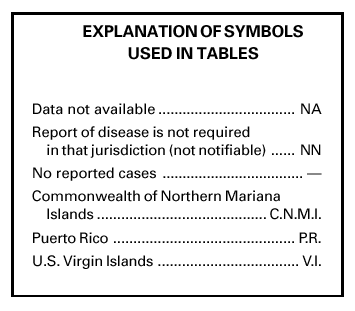
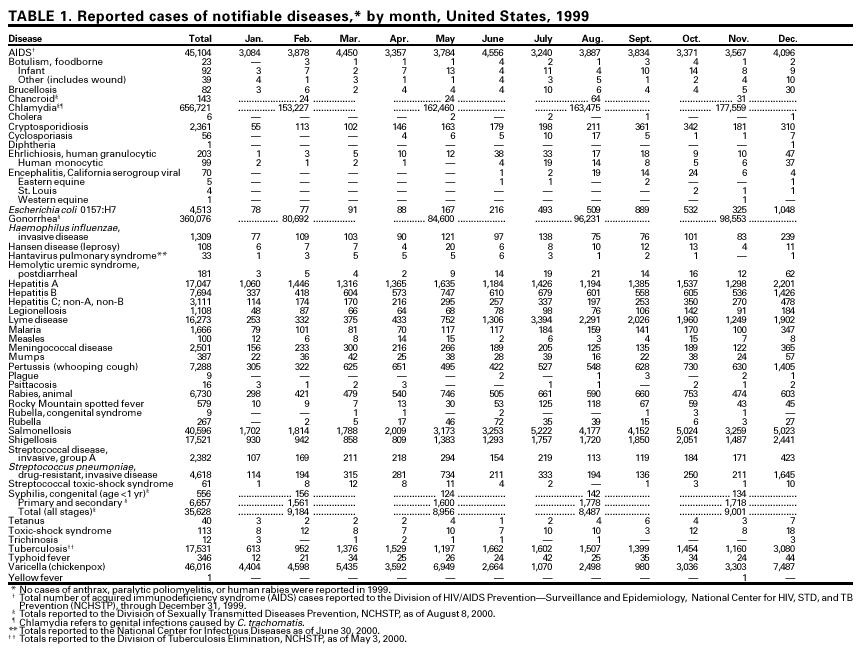
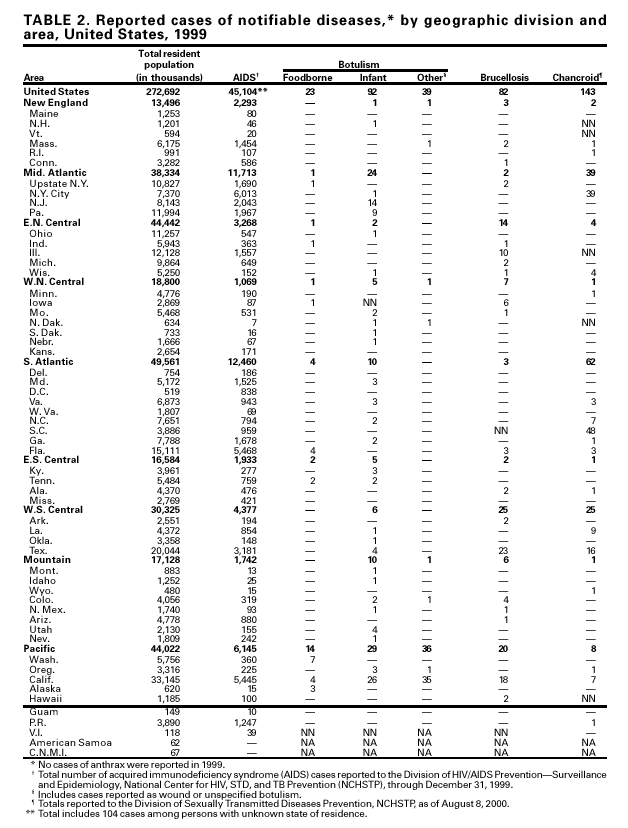
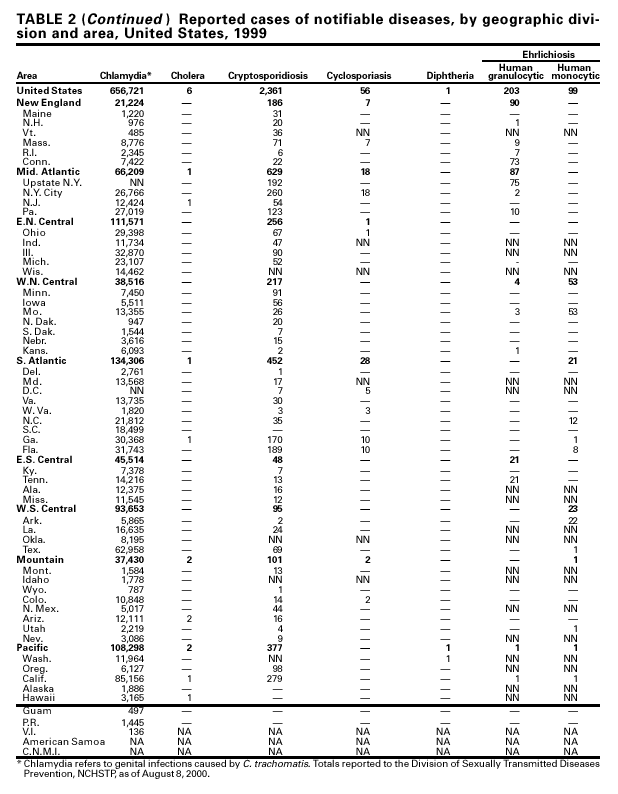
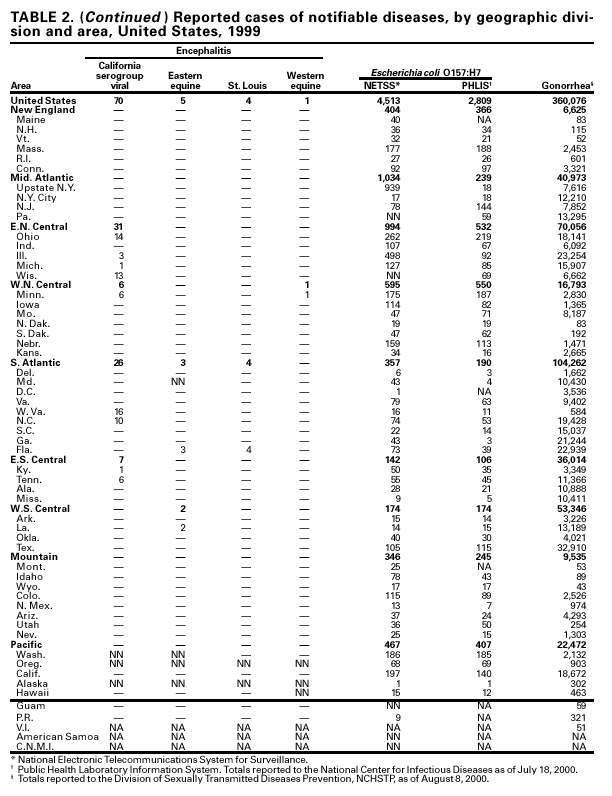
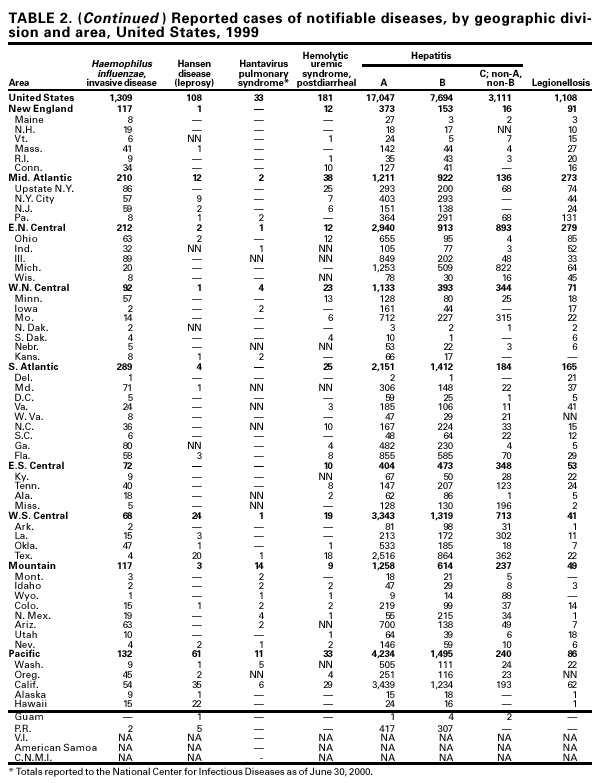
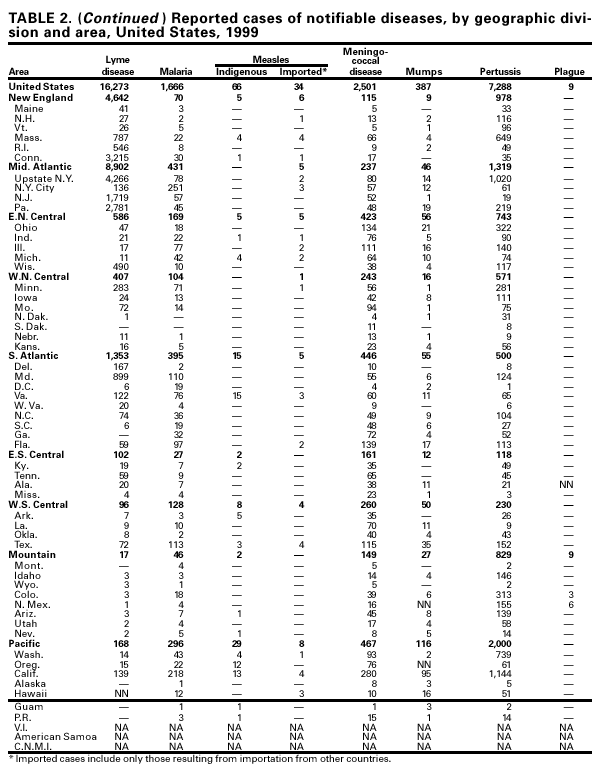
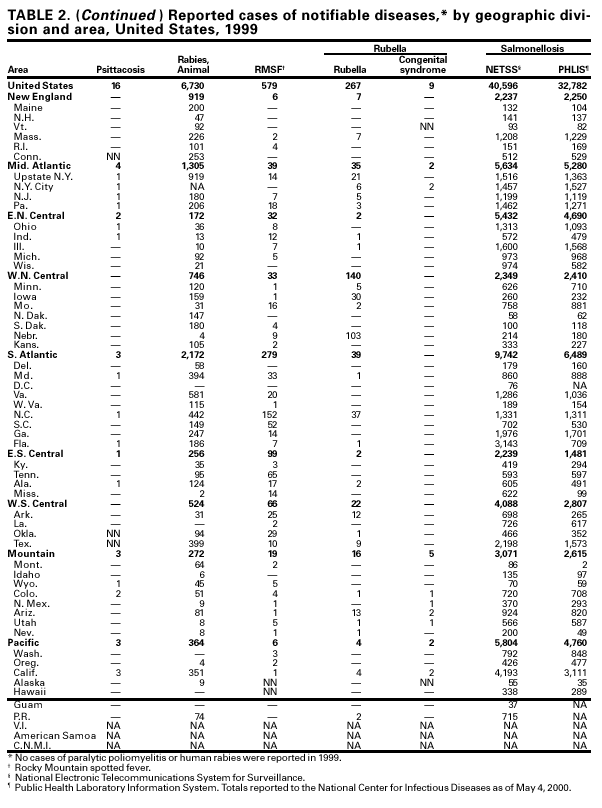
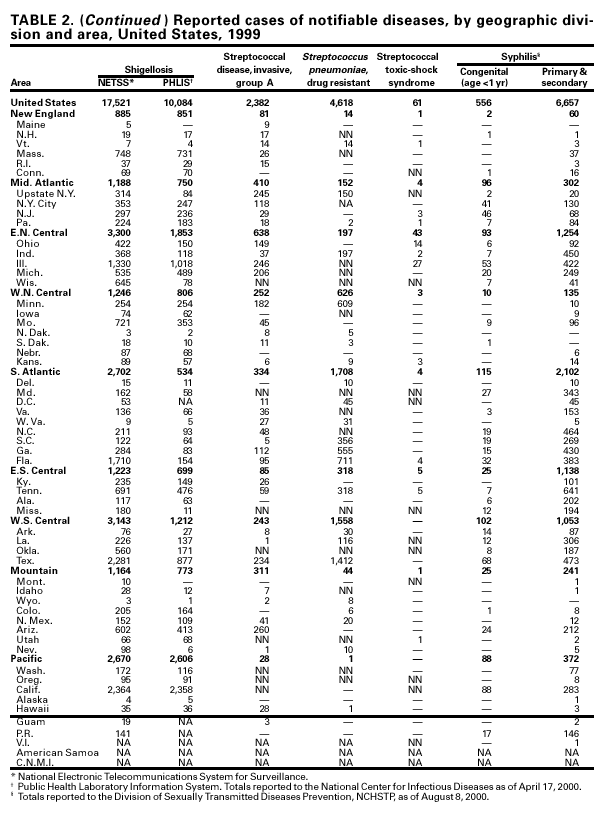
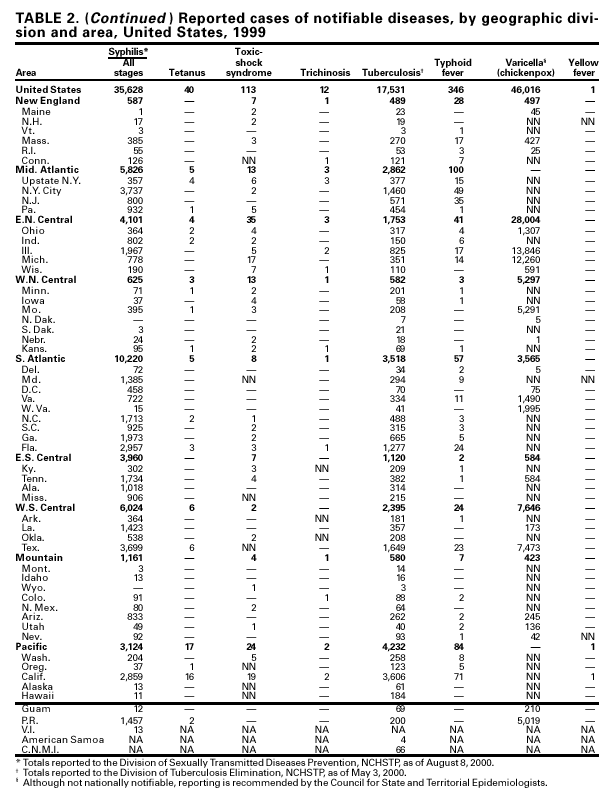
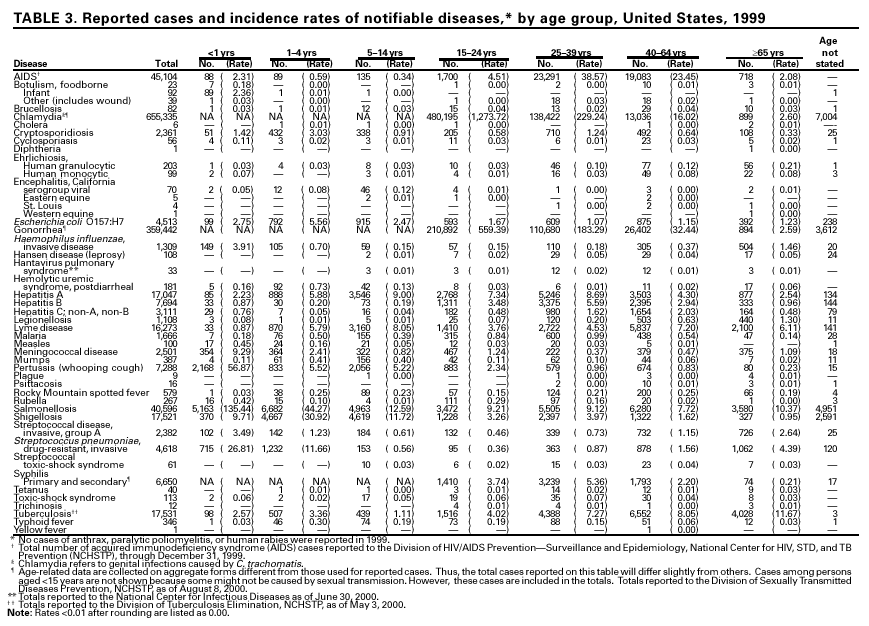
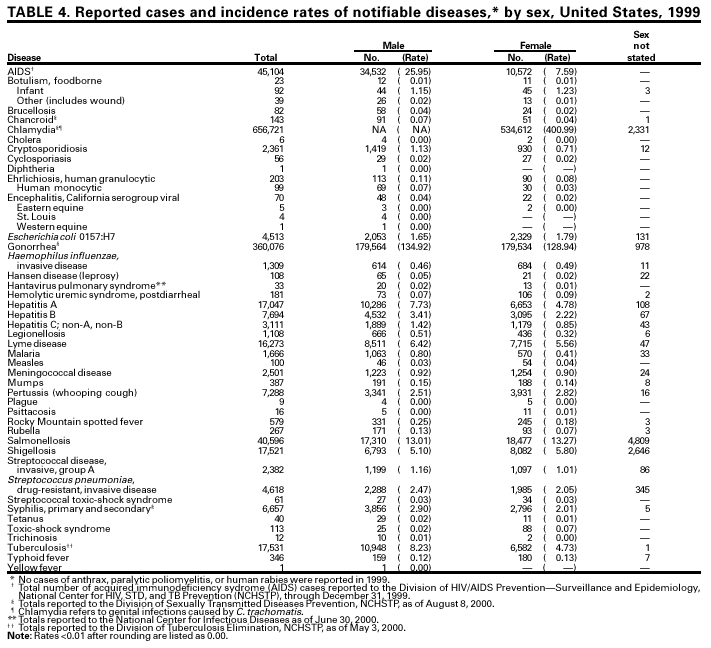
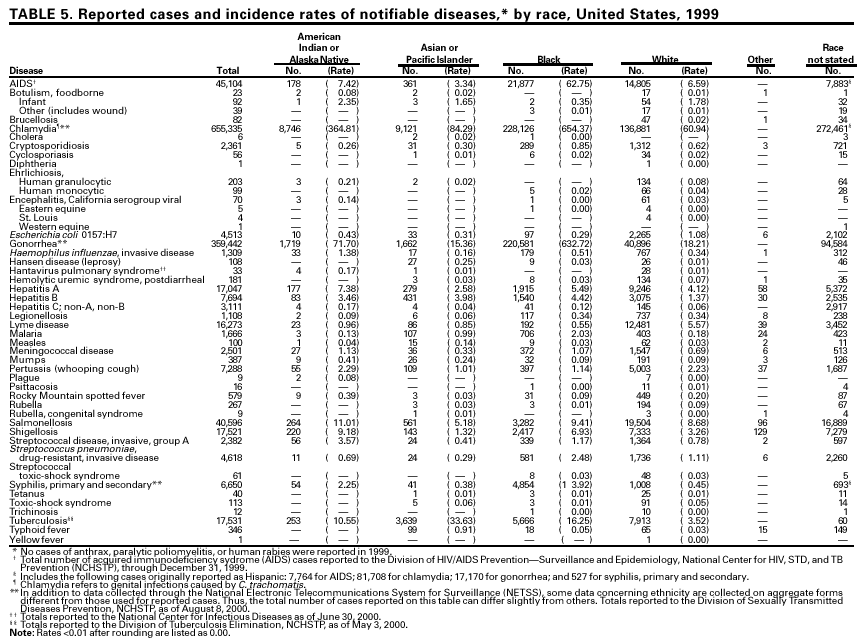
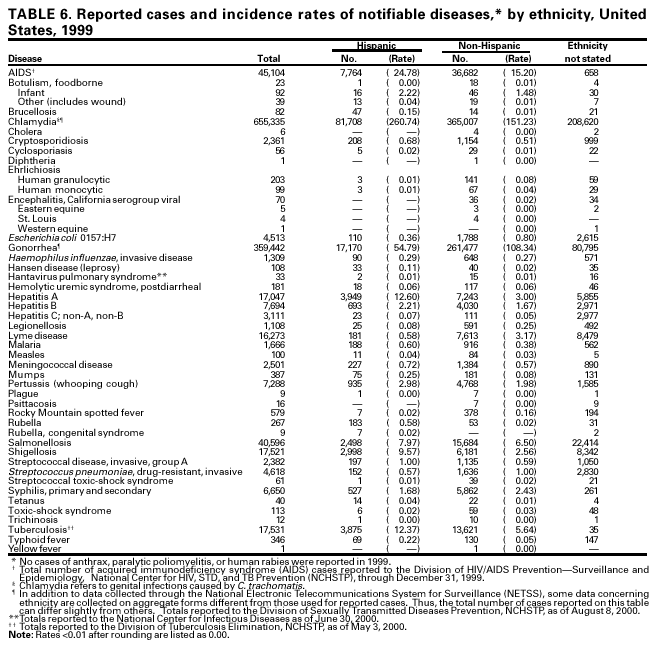
Part 2. Graphs and Maps for Selected Notifiable Diseases in the United States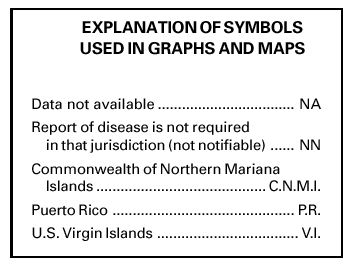
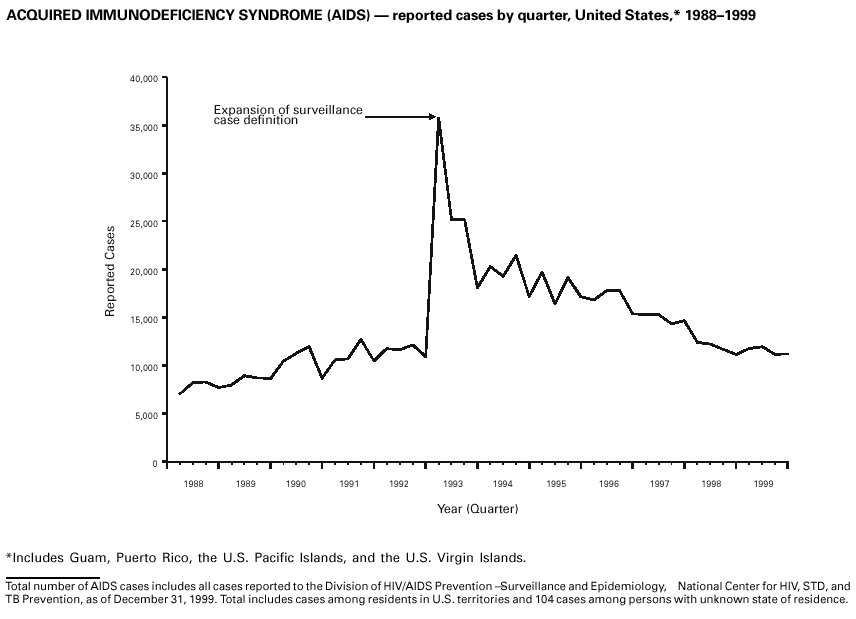
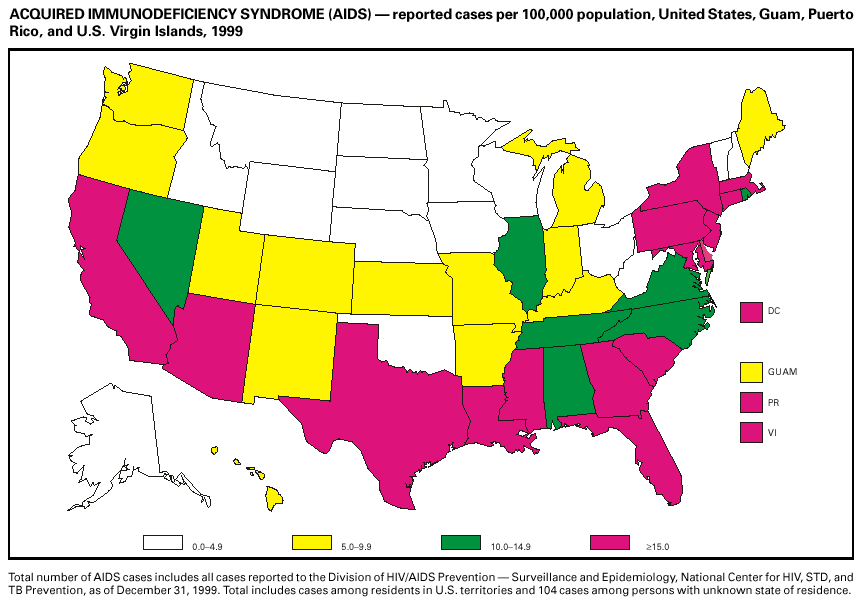
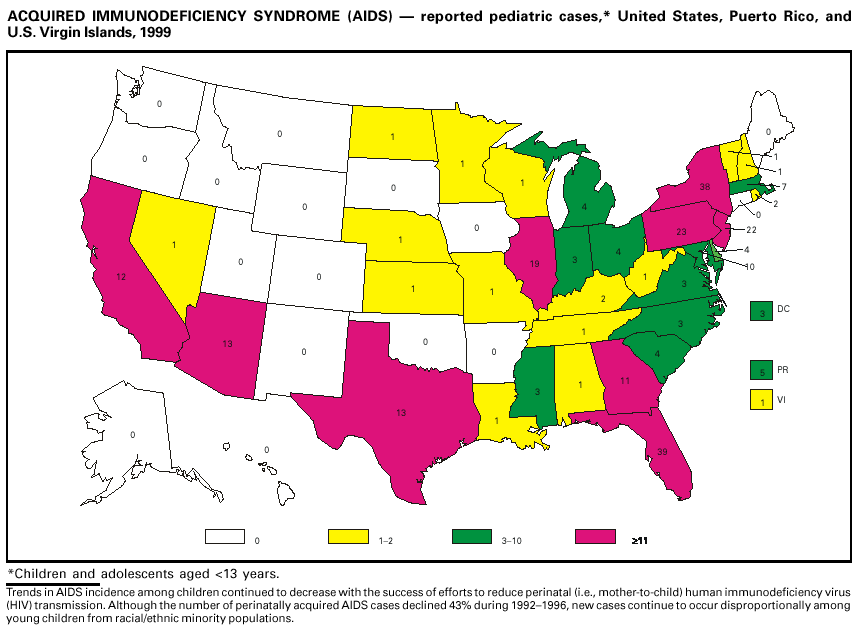
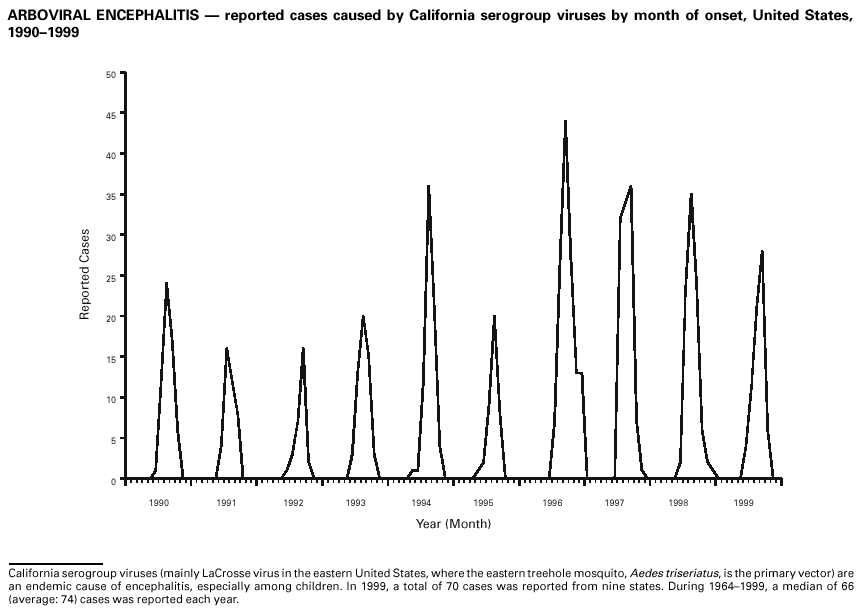
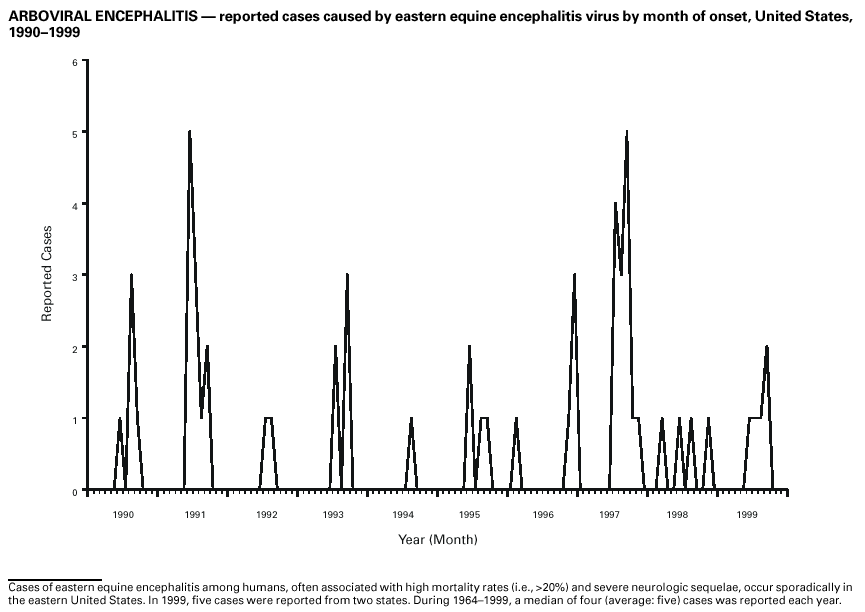
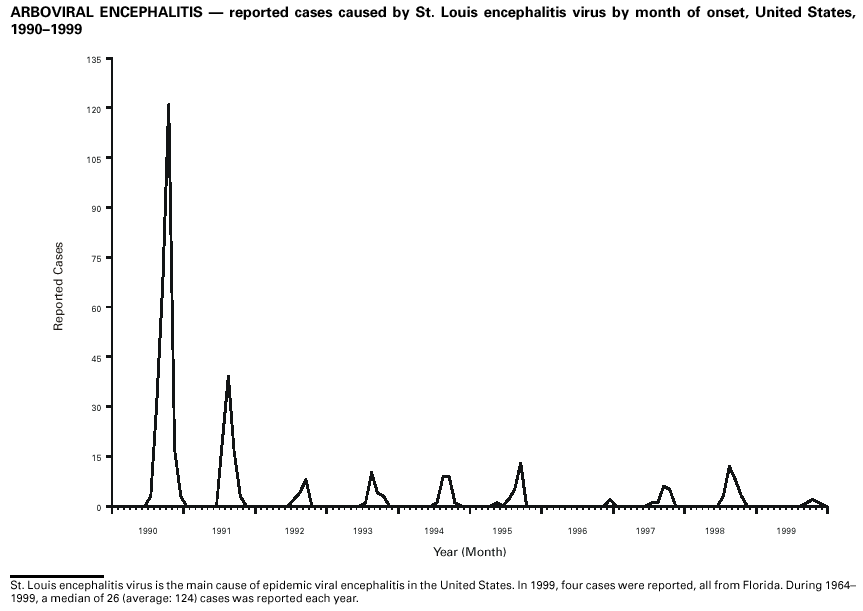
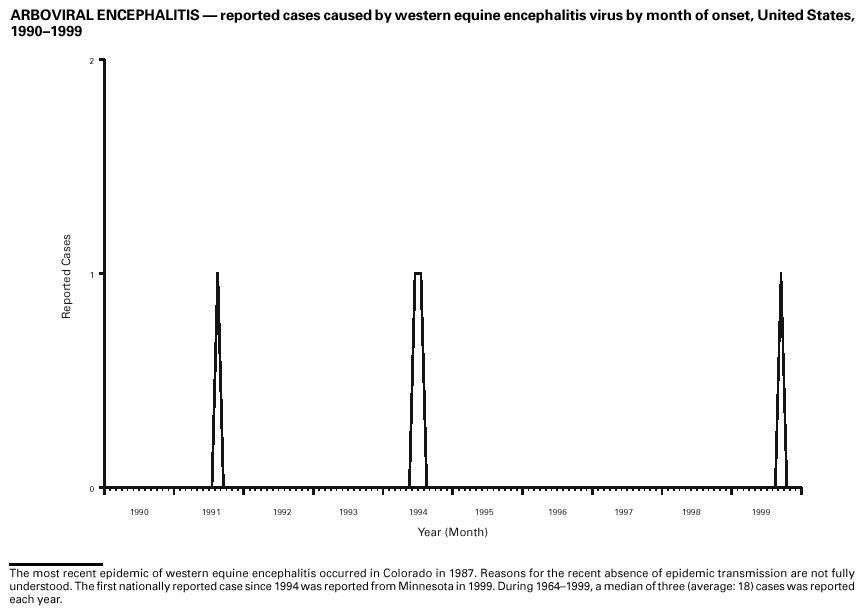
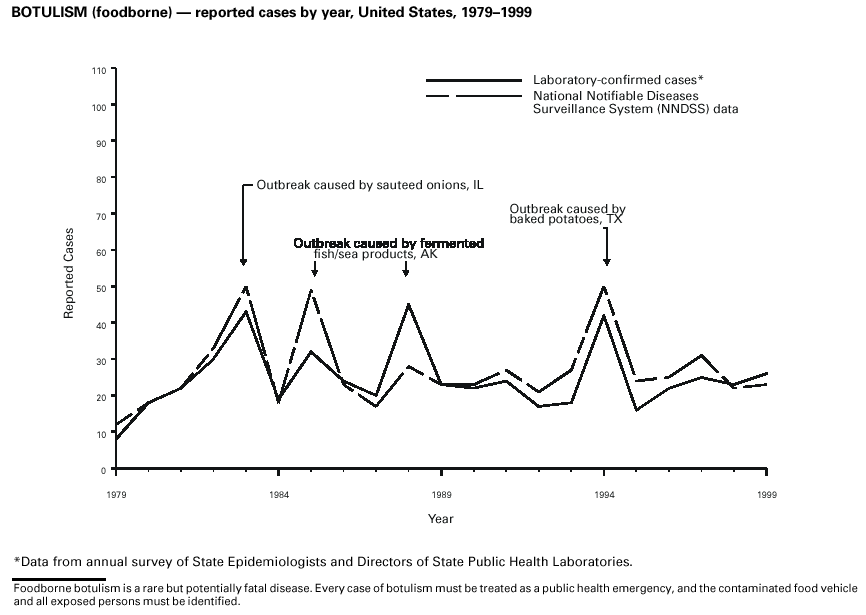
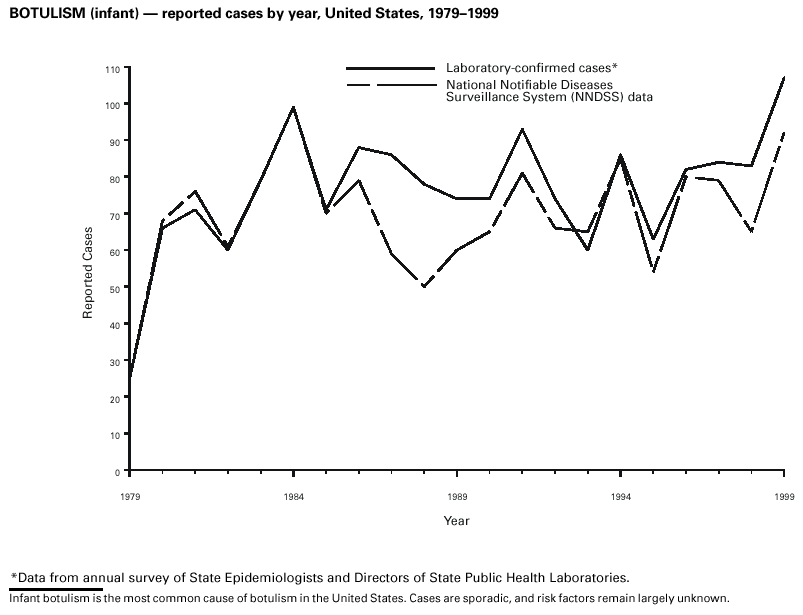
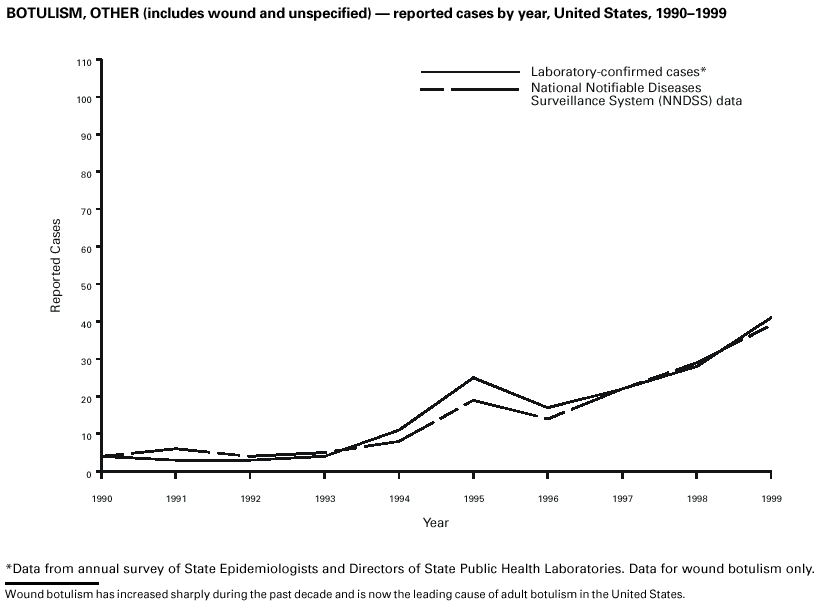
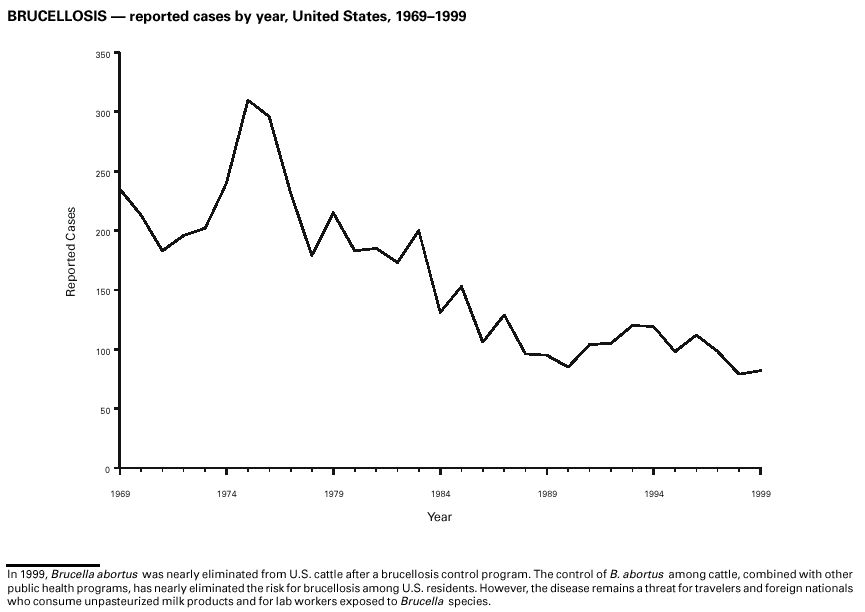
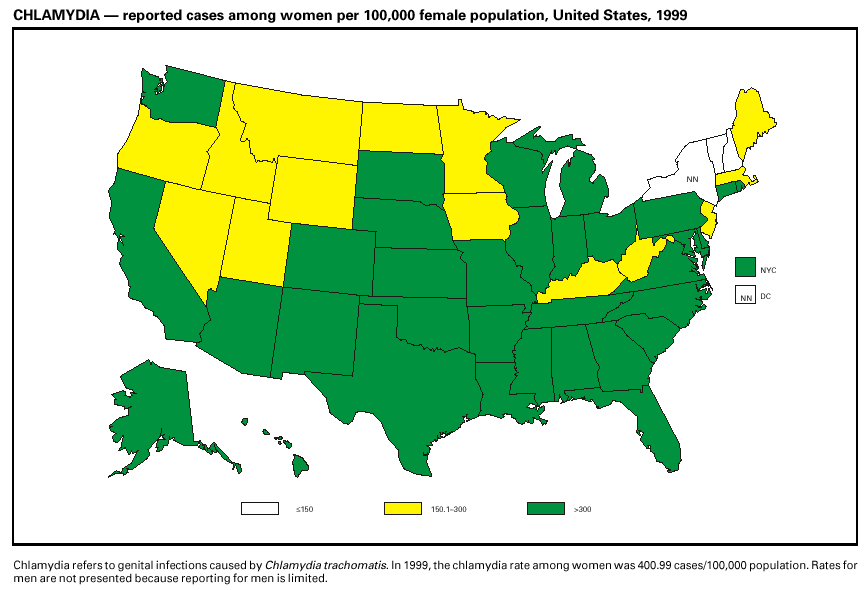

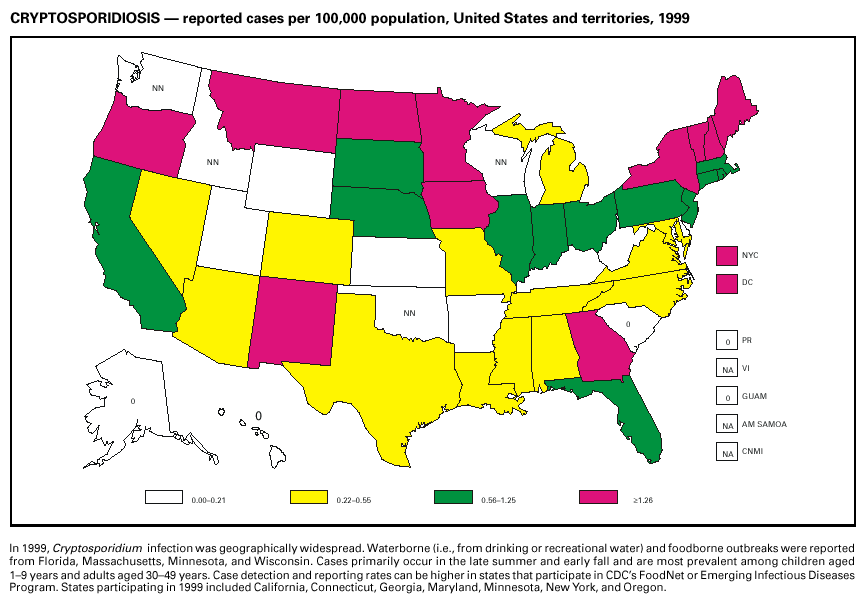
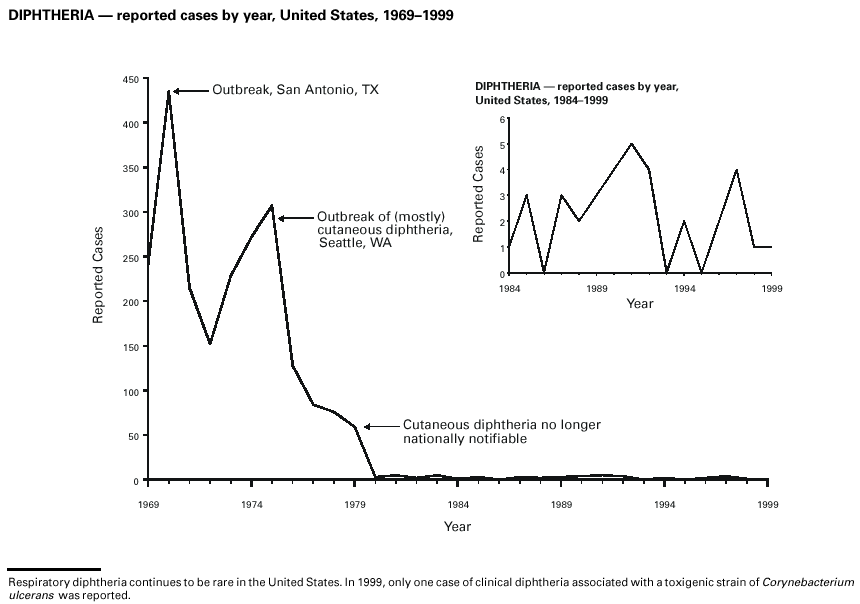
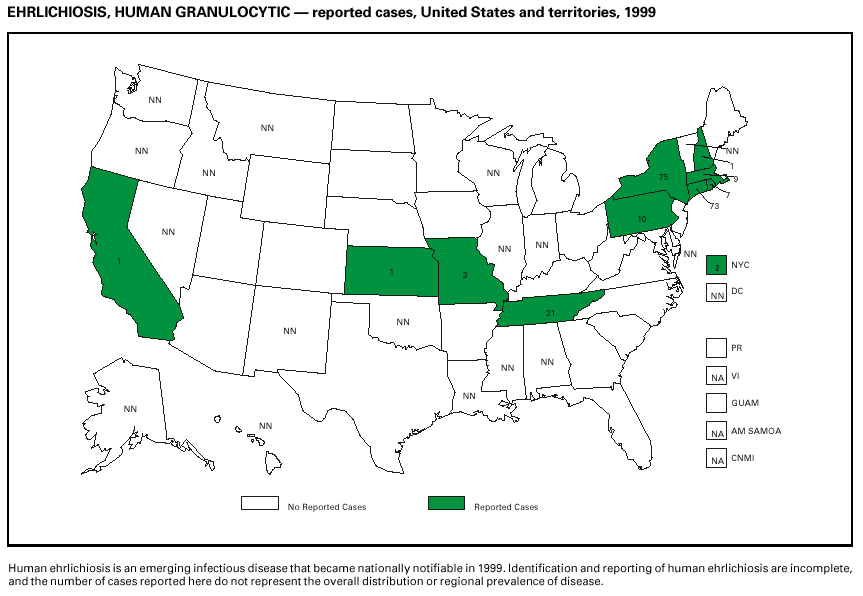
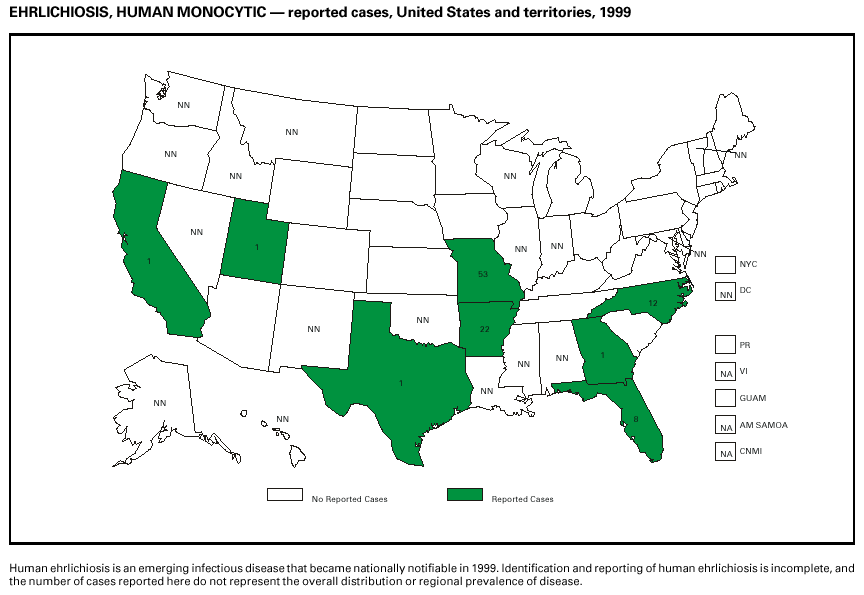
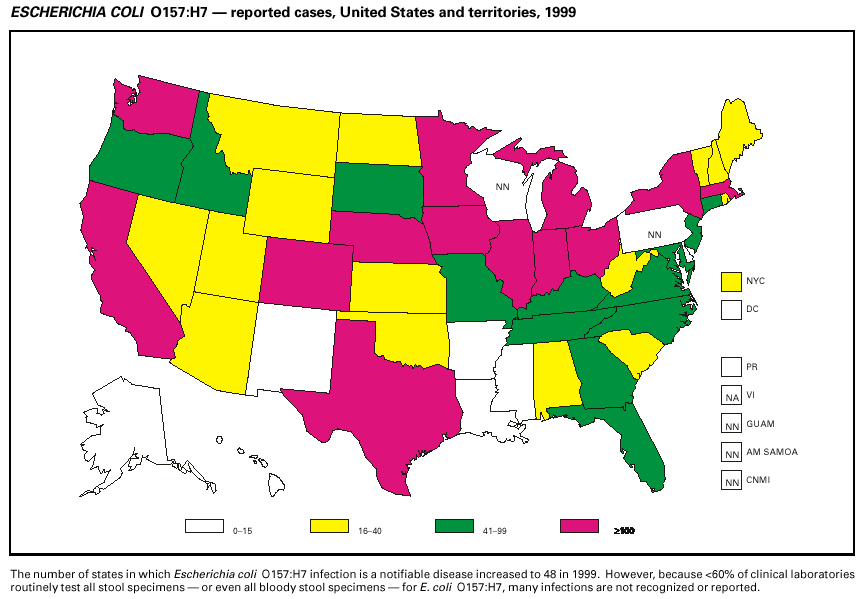
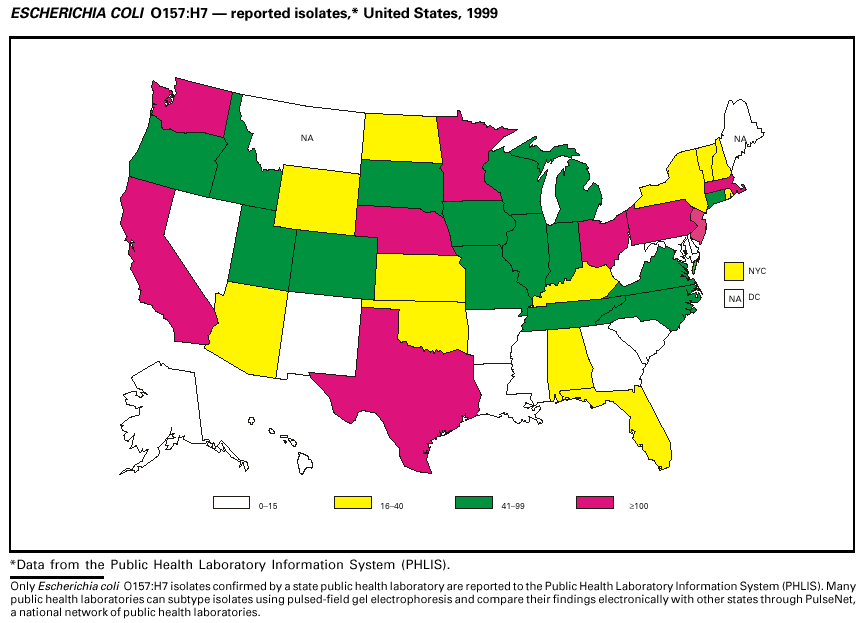
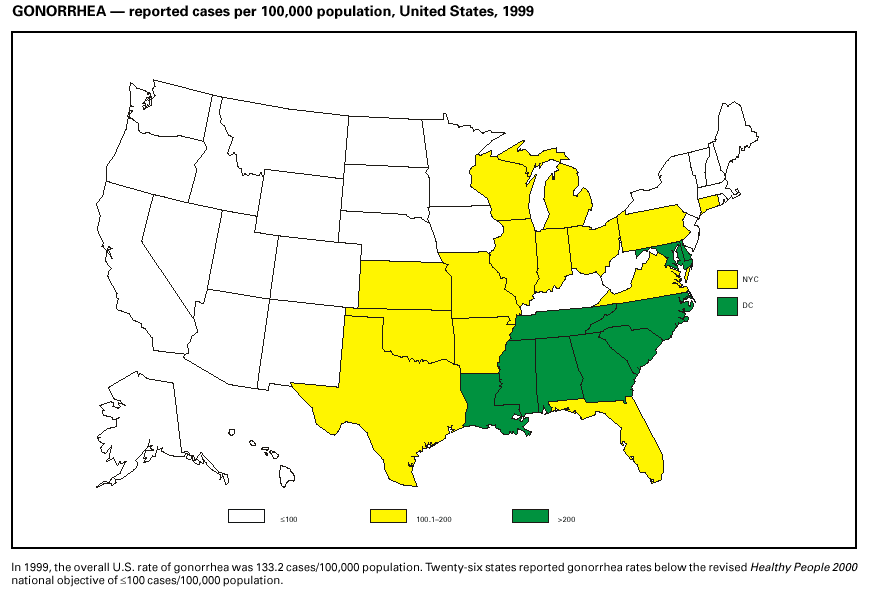
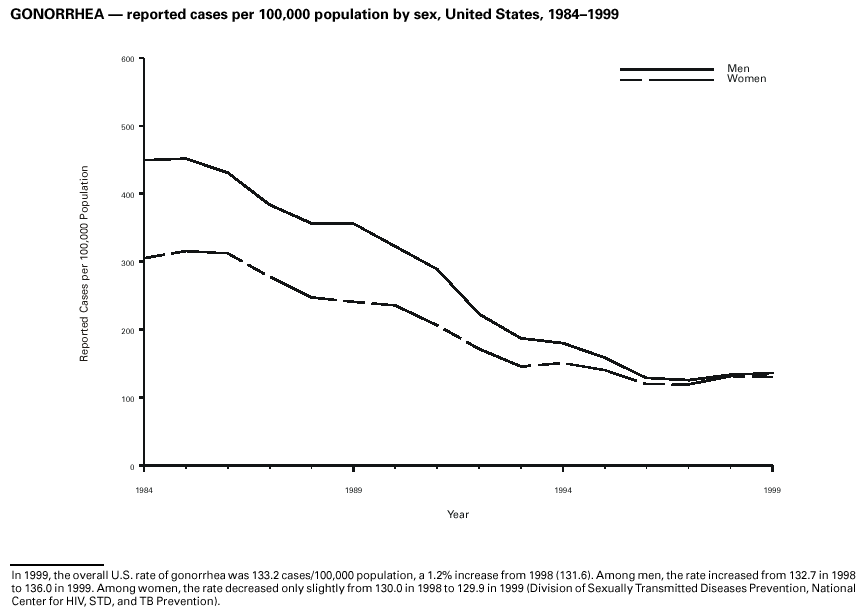
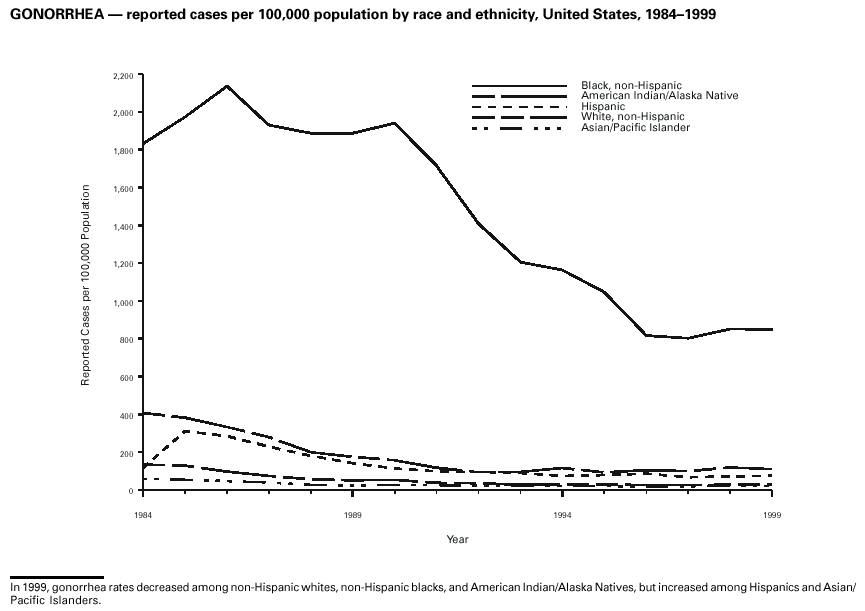
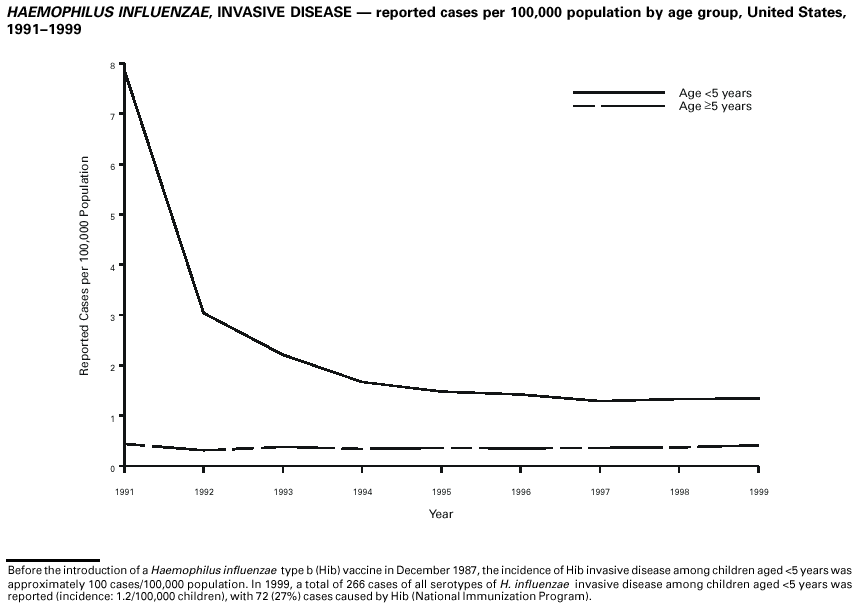
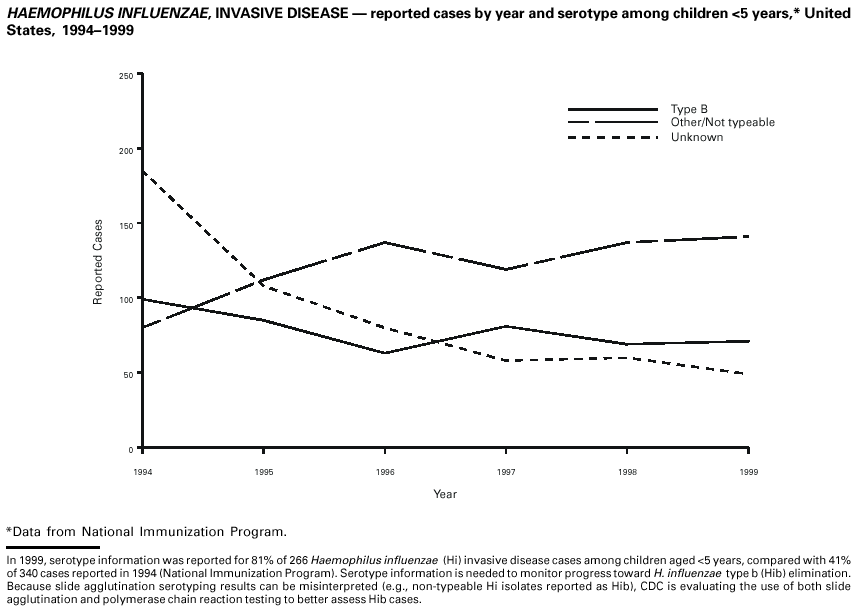
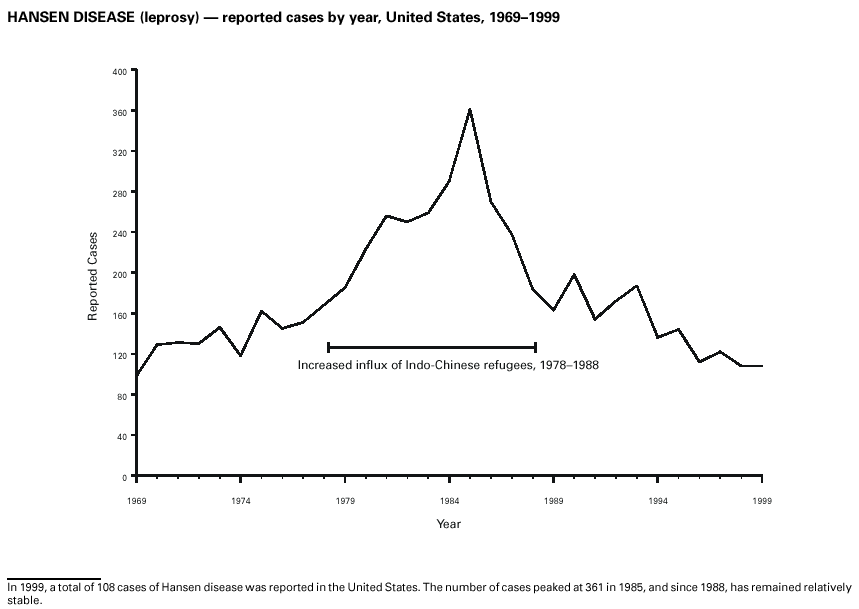

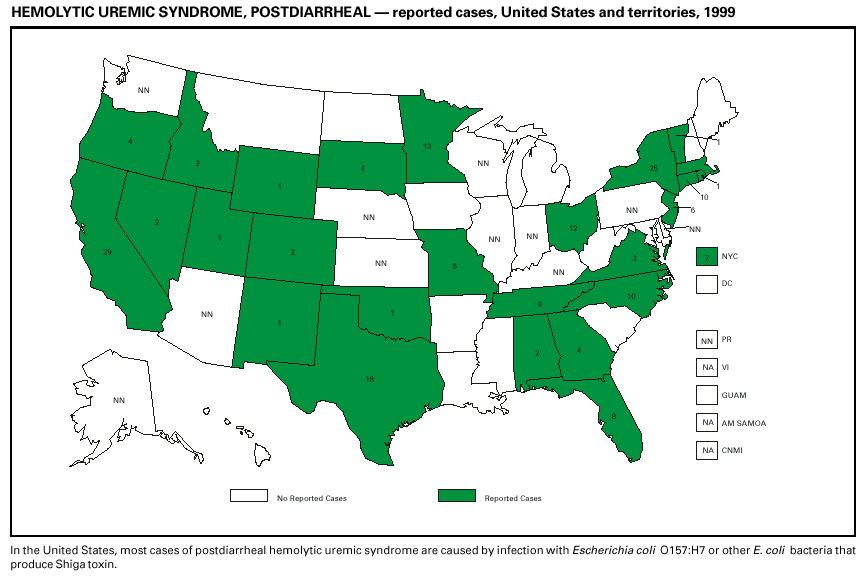
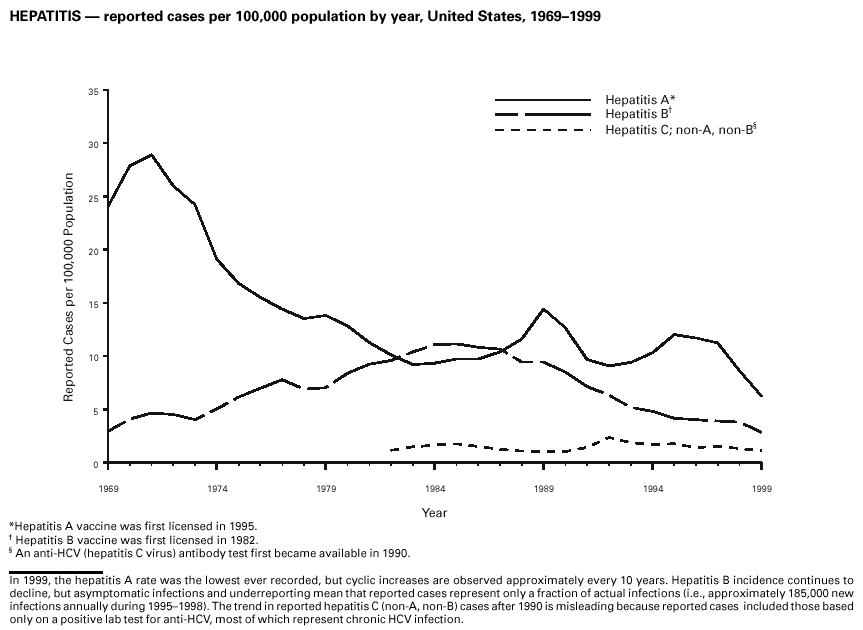
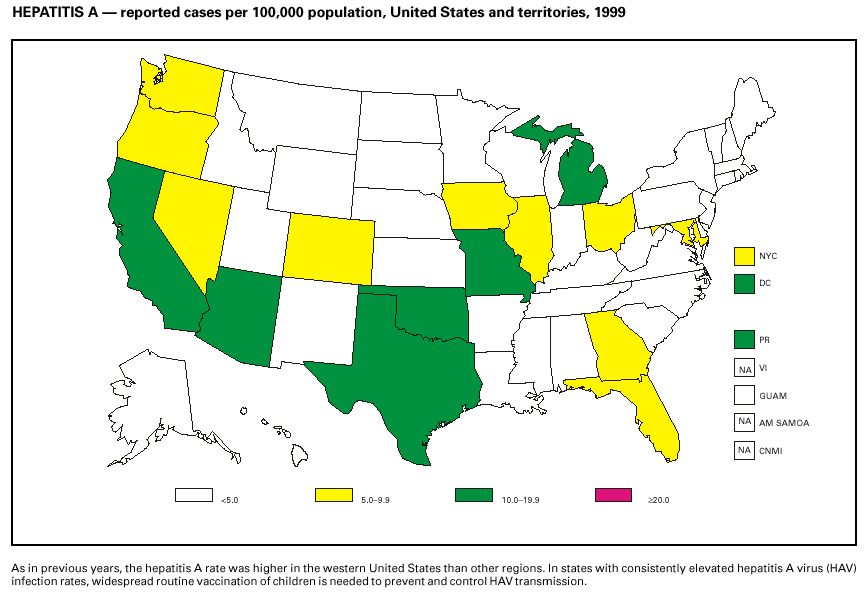
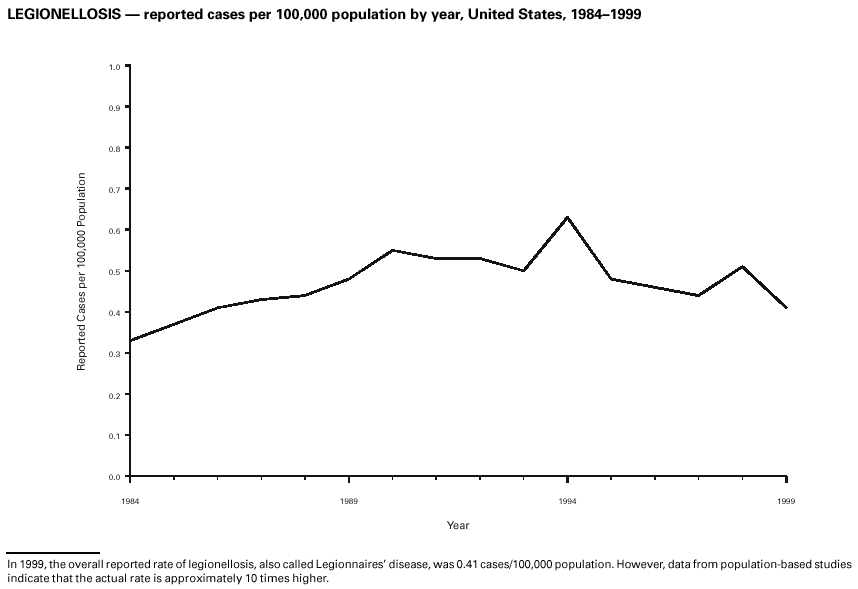
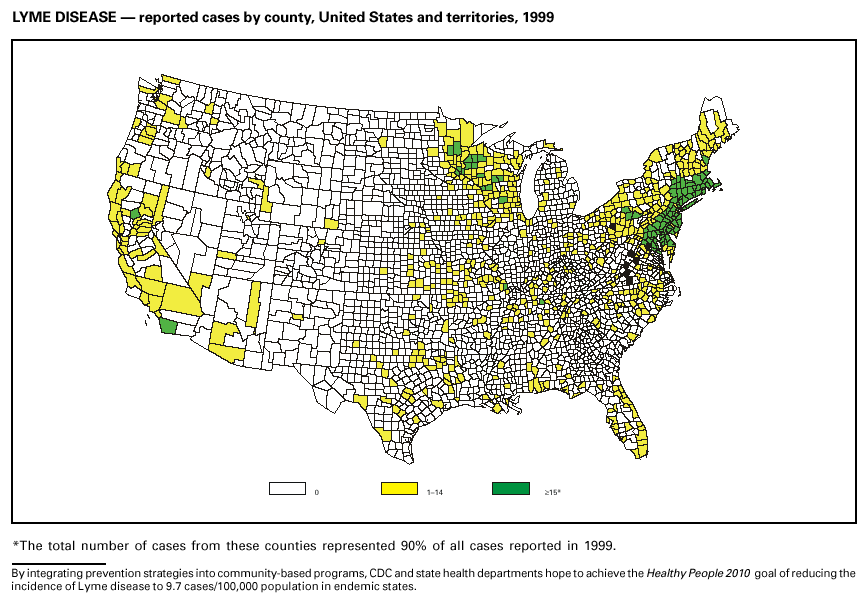
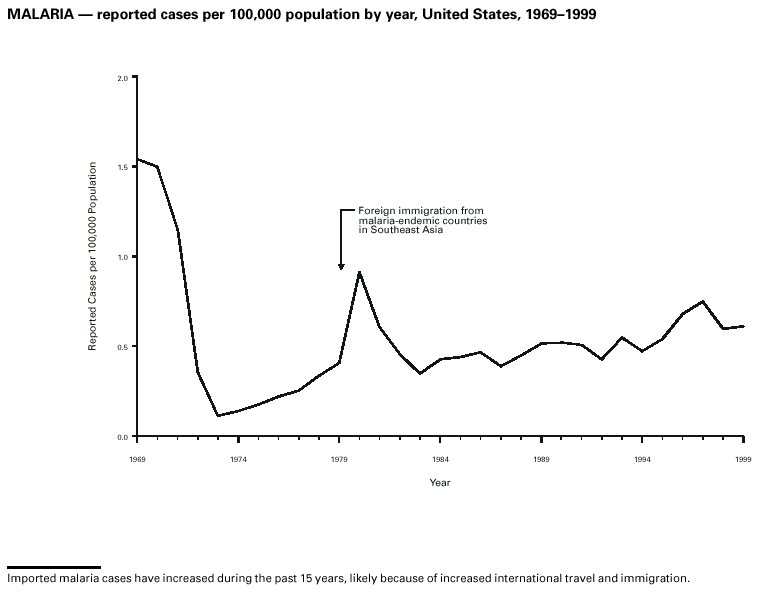
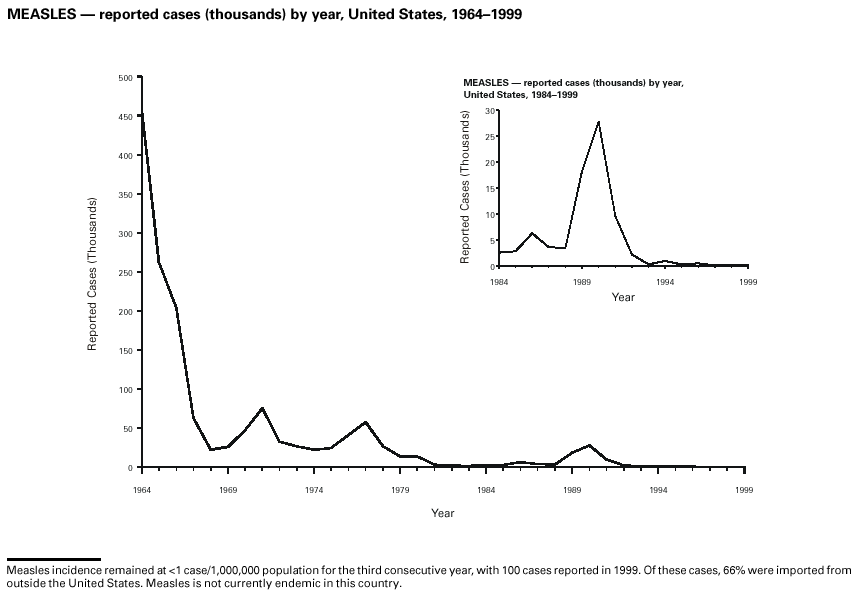
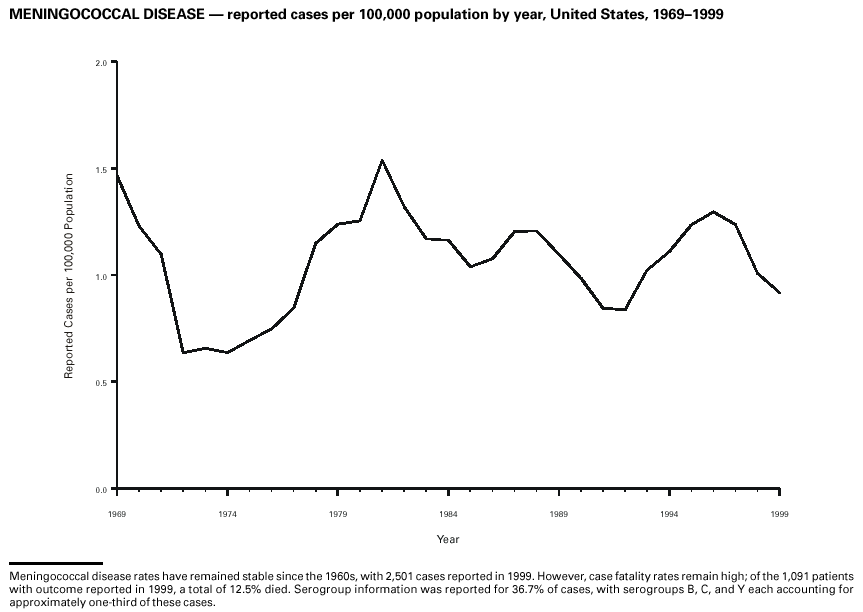
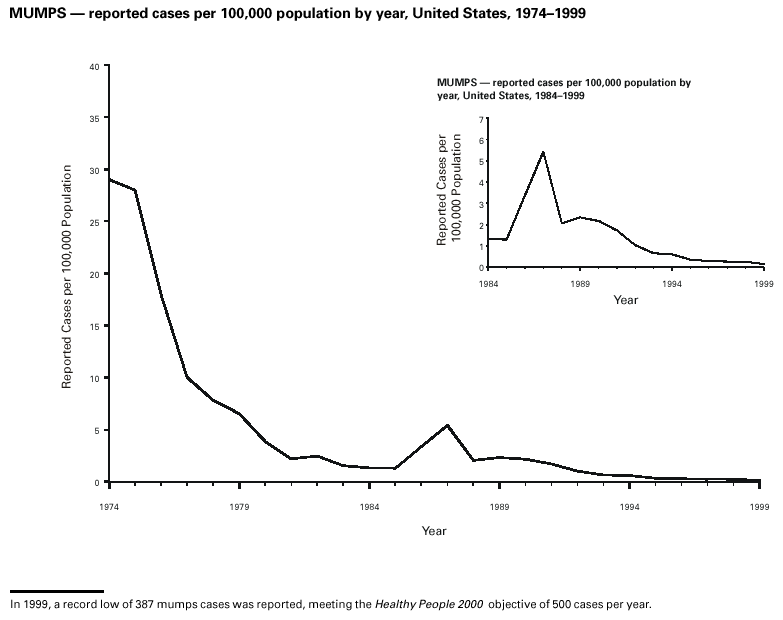
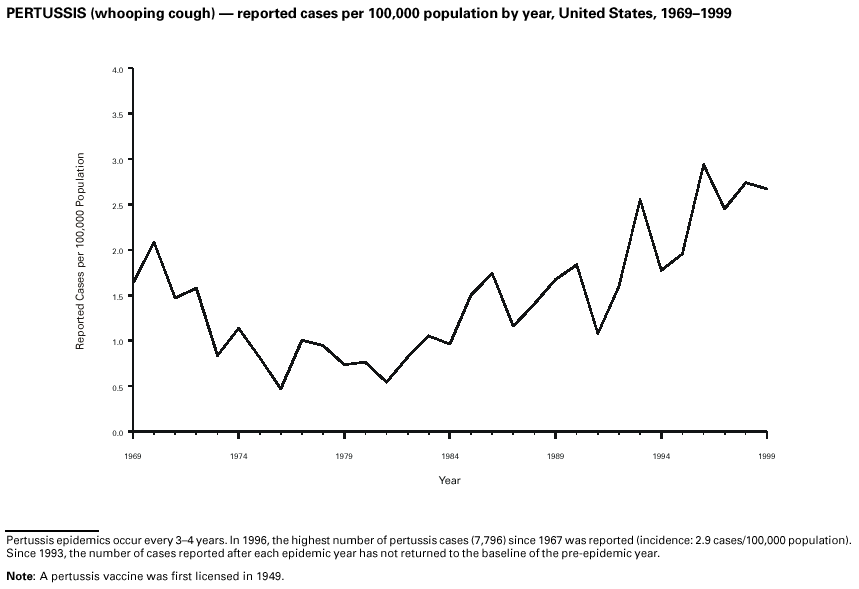
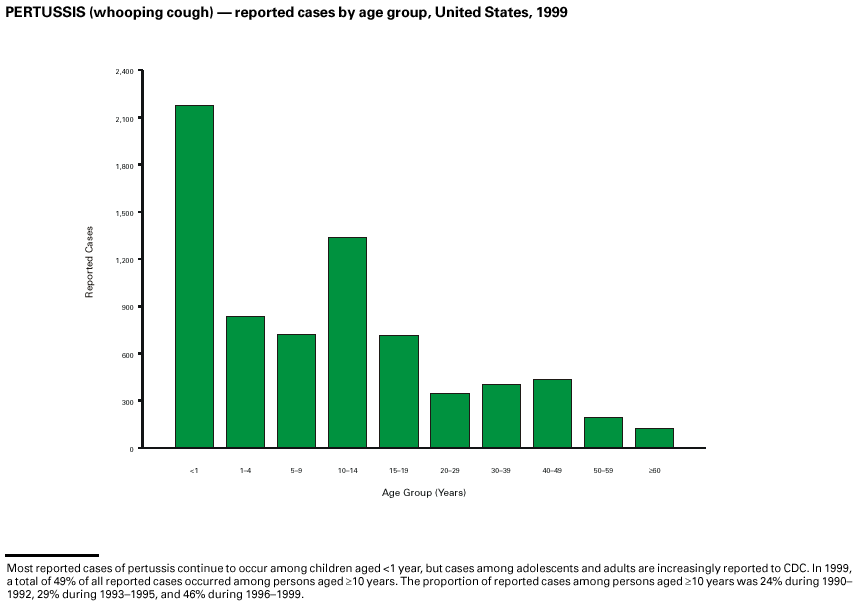
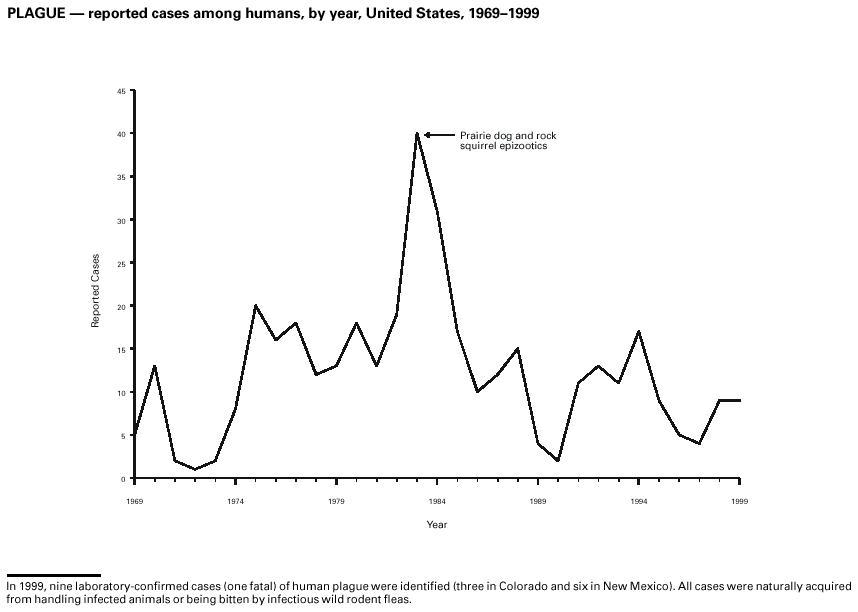
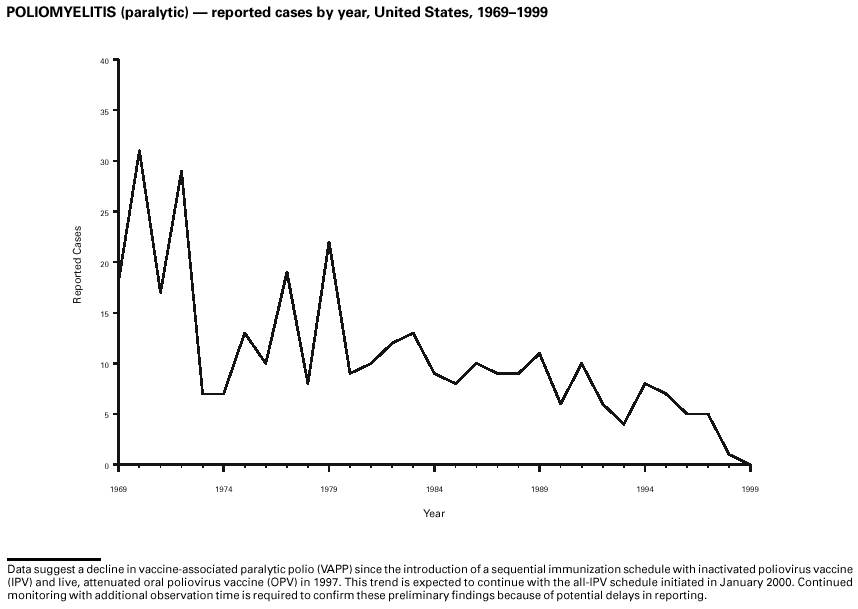

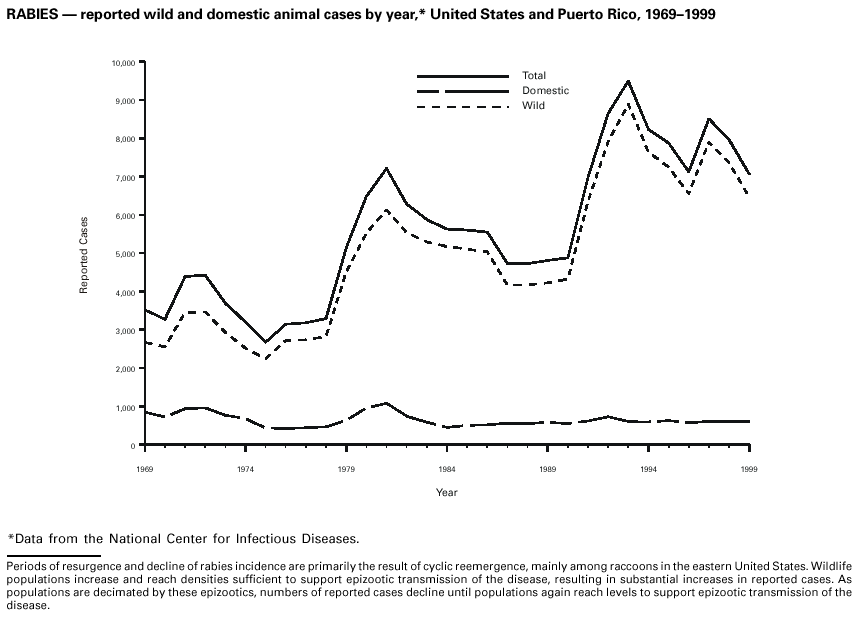
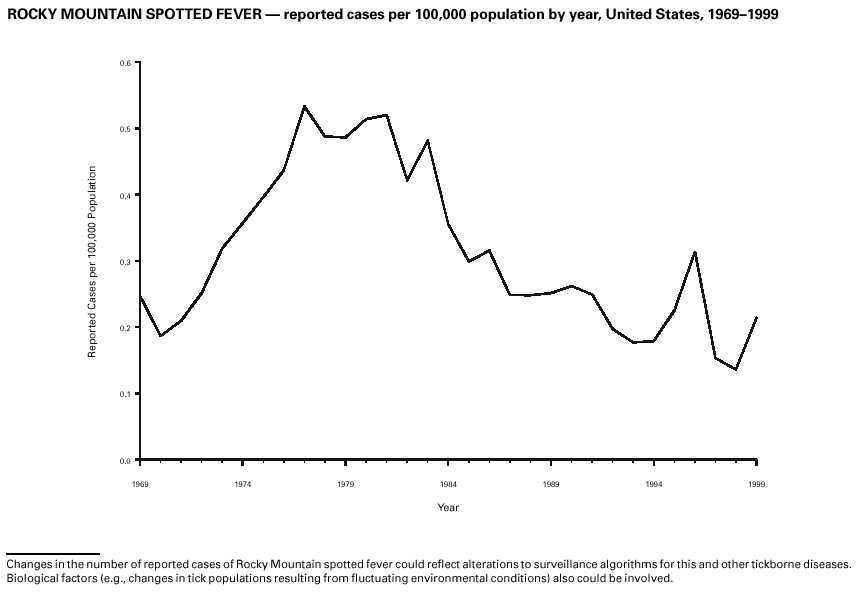
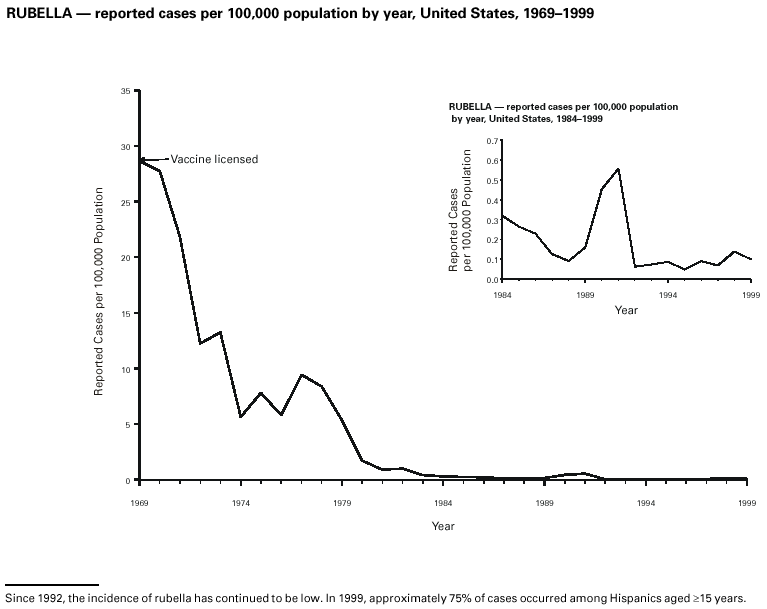
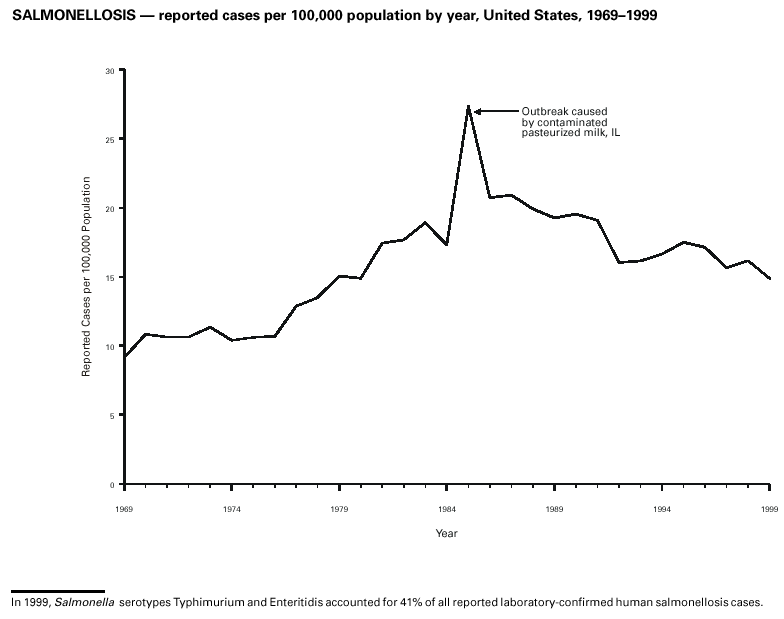
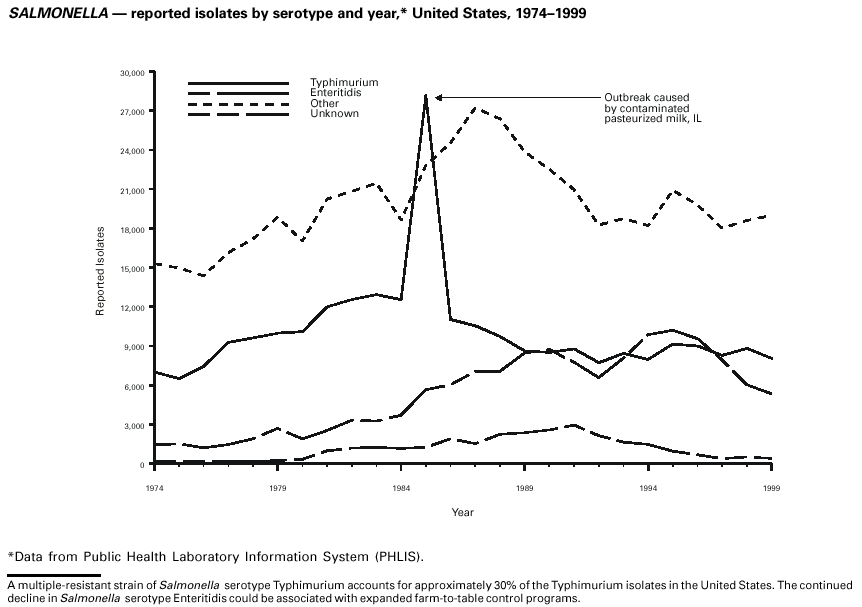
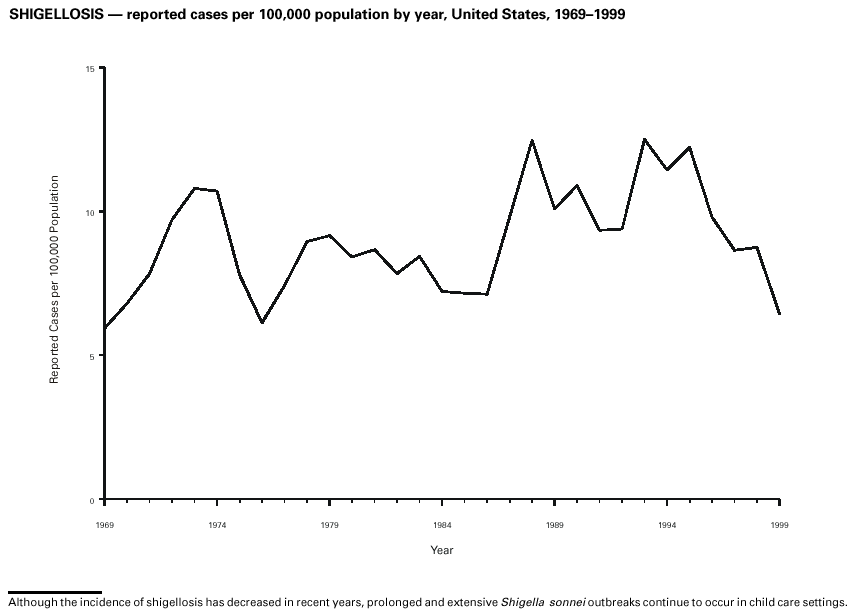
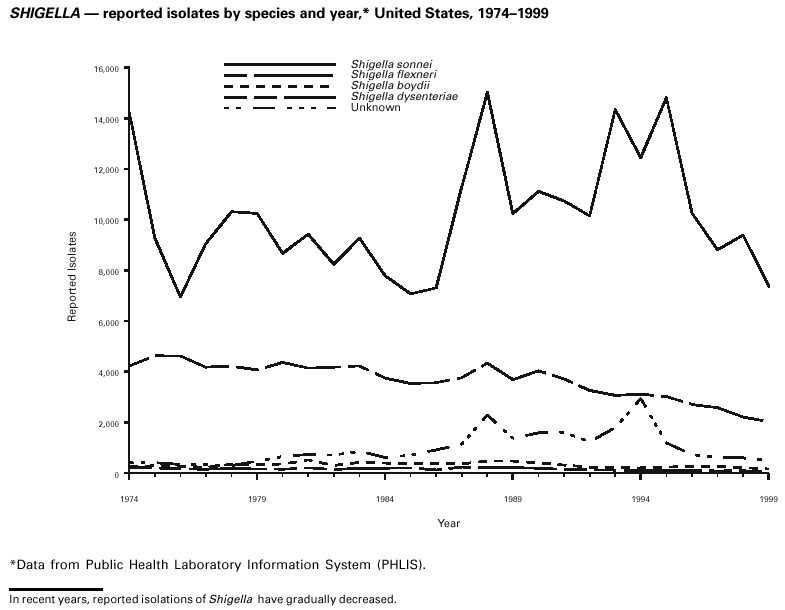

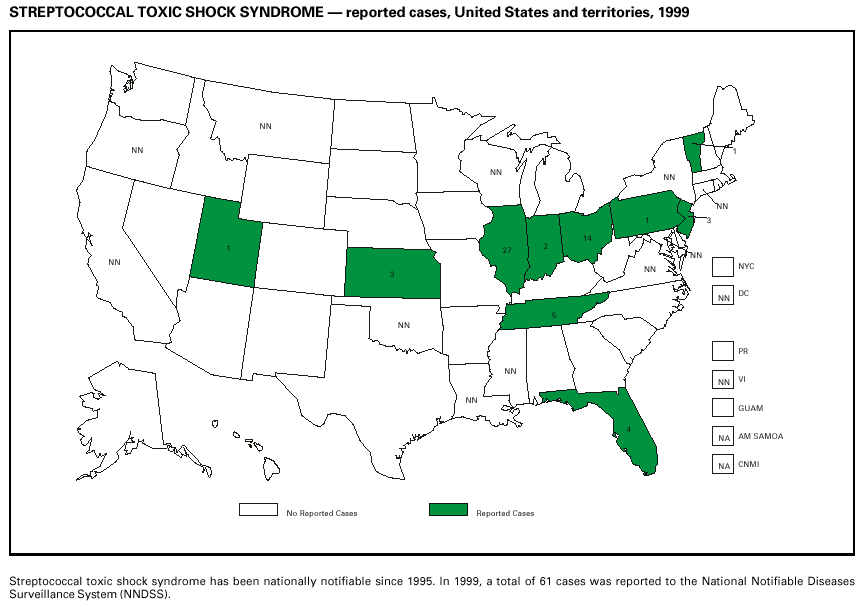
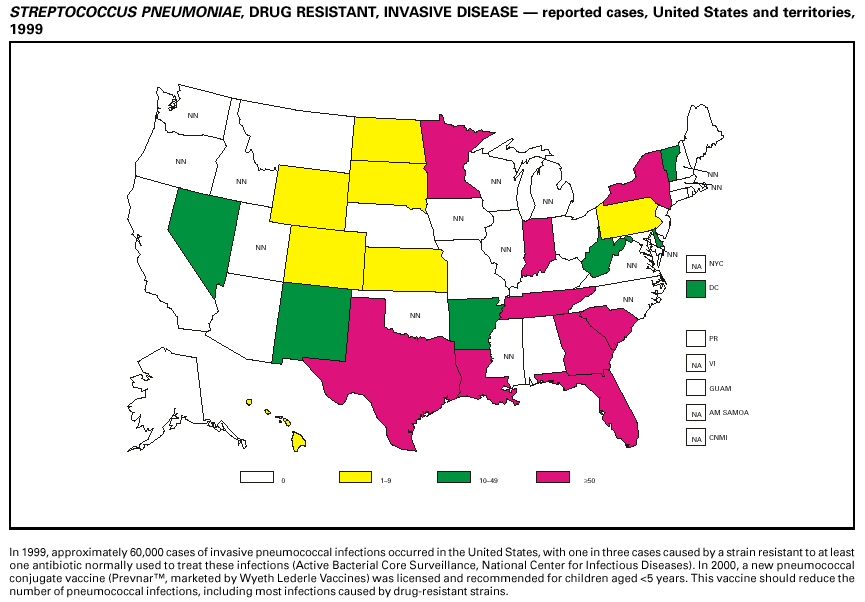
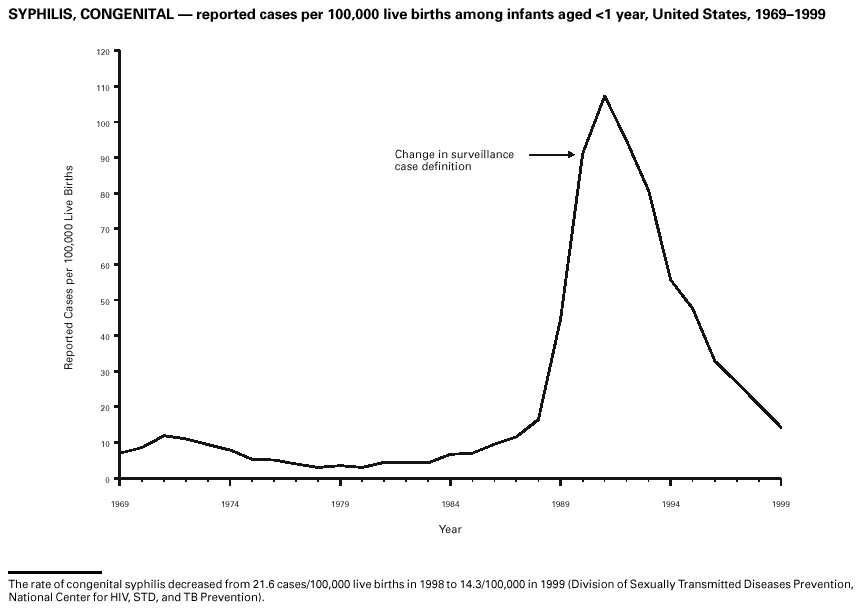
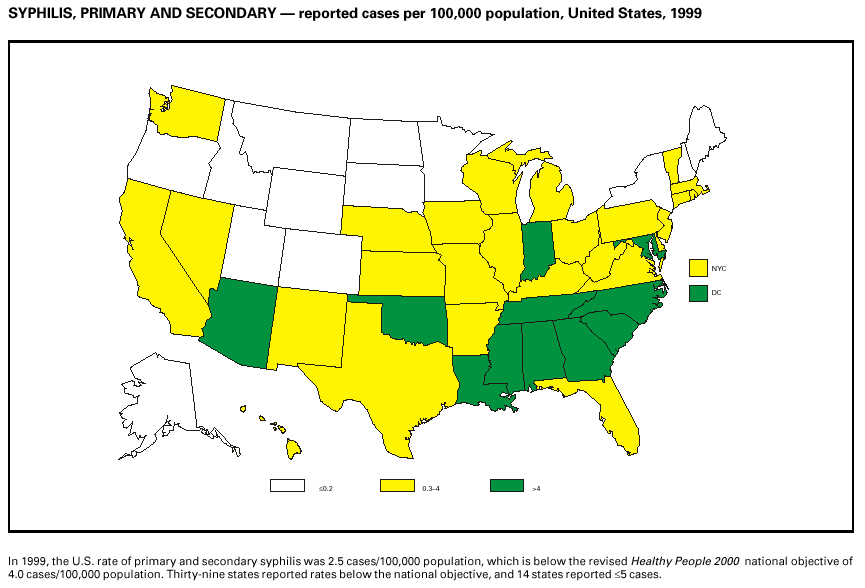
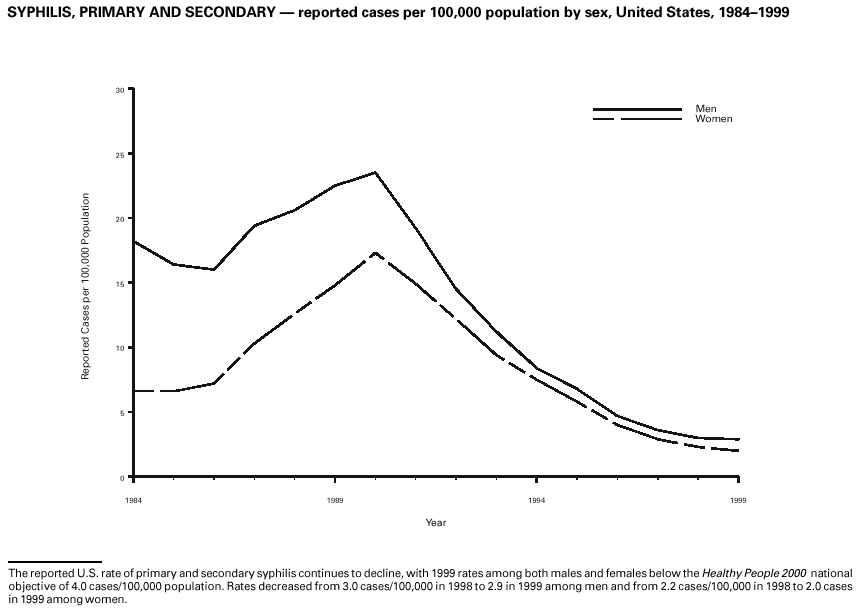
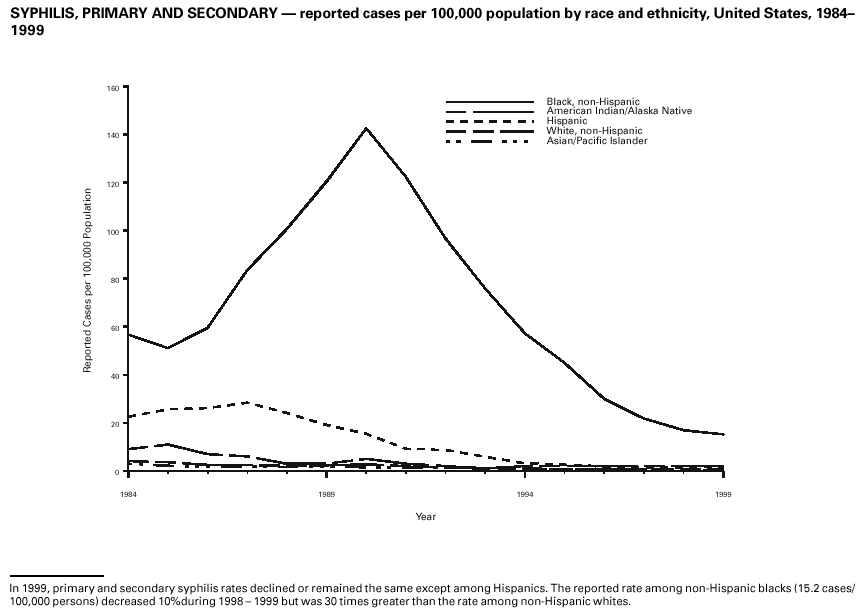

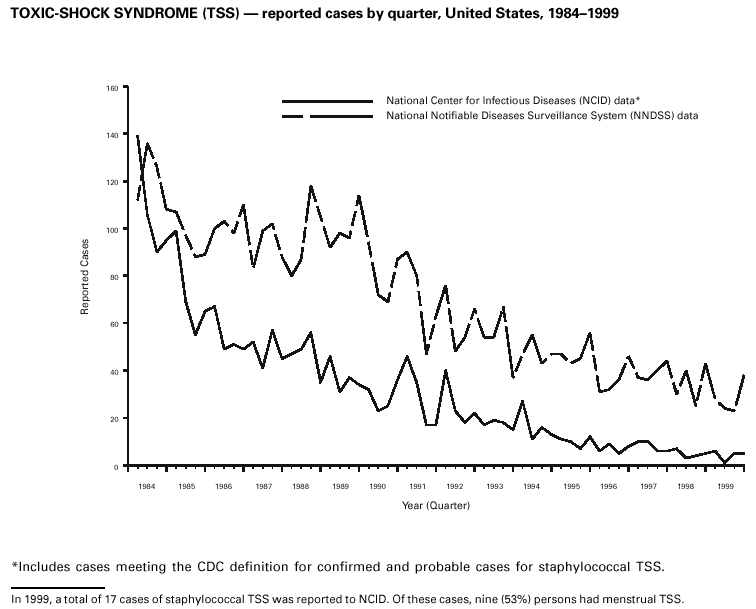

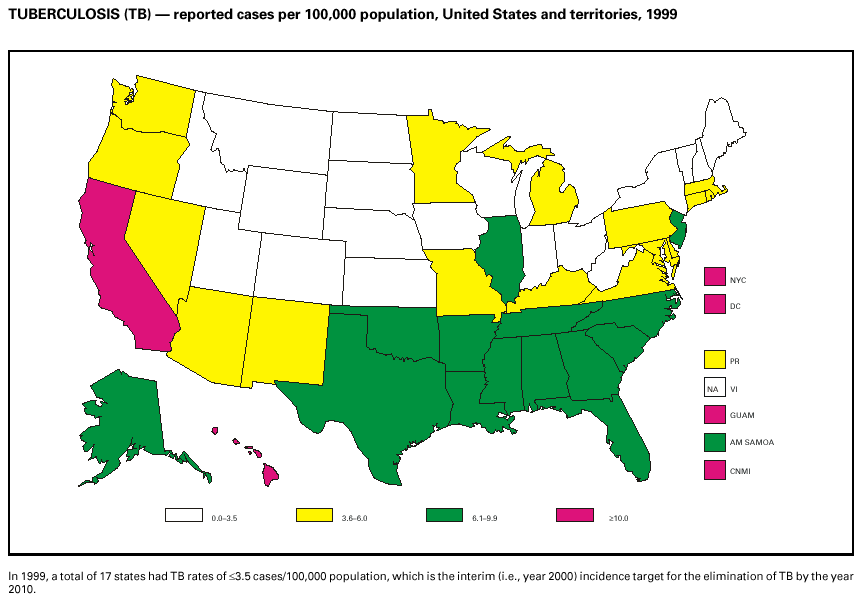
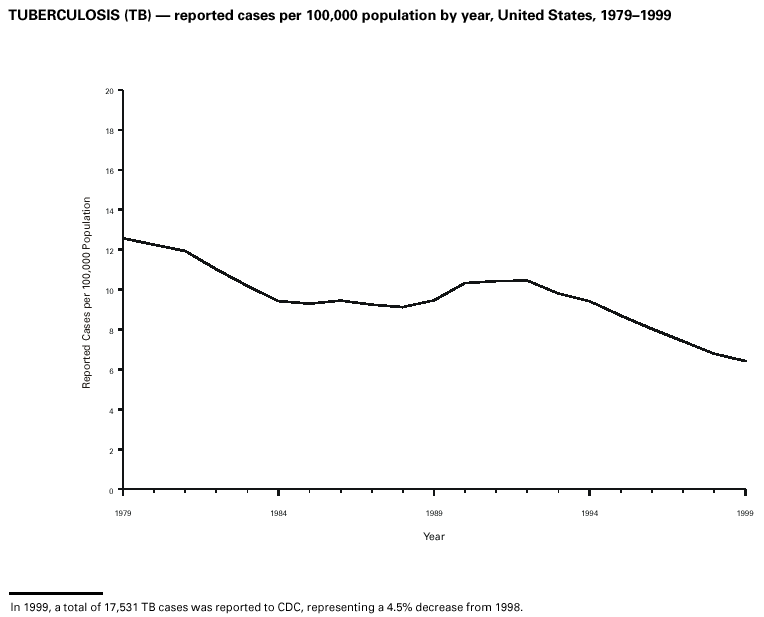
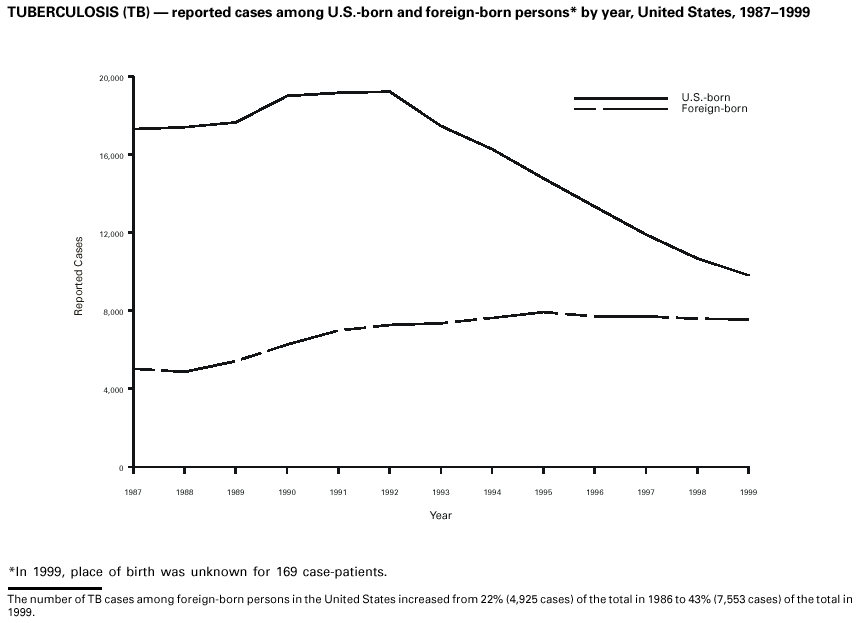
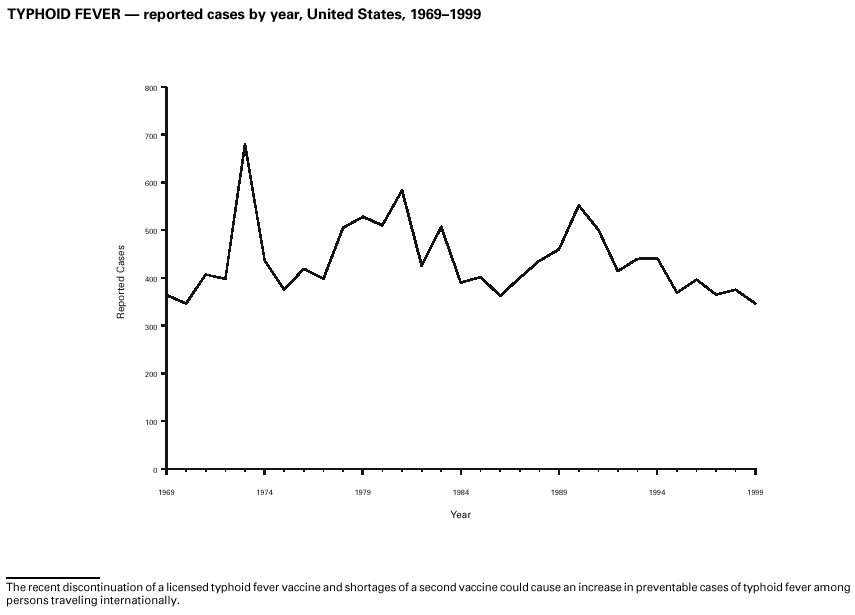
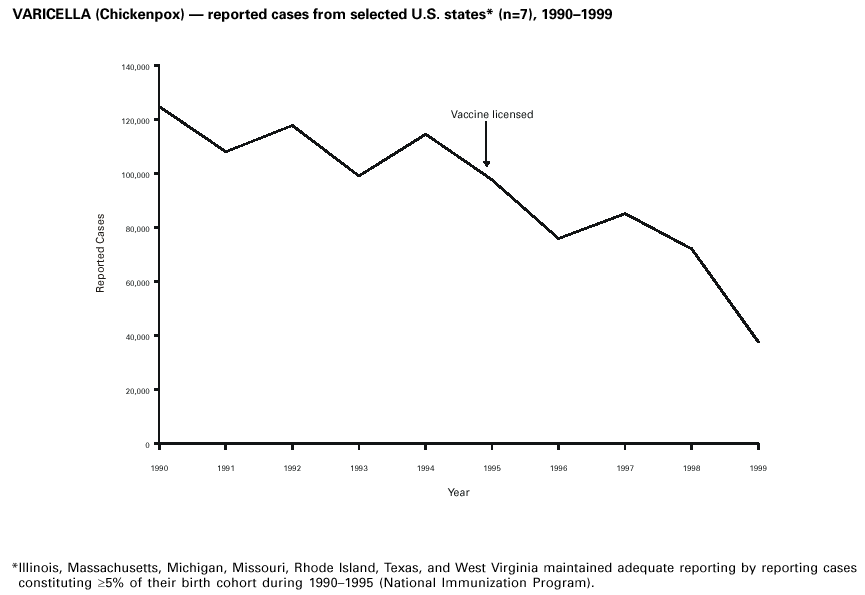
Part 3. Historical Summaries of Notifiable Diseases in the United States, 1968--1999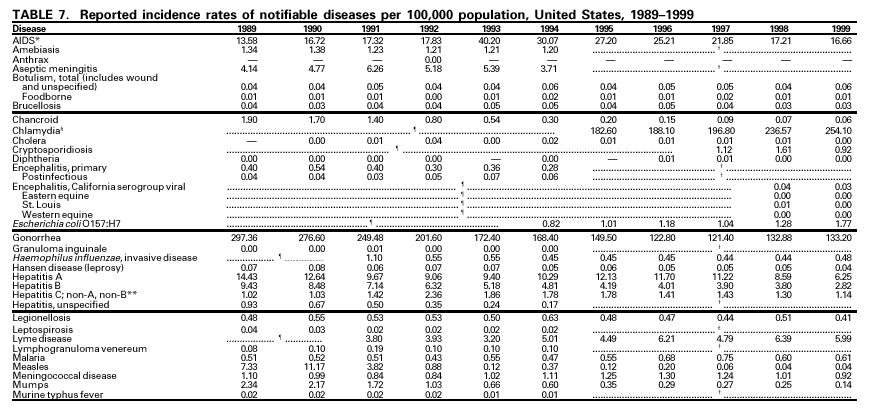

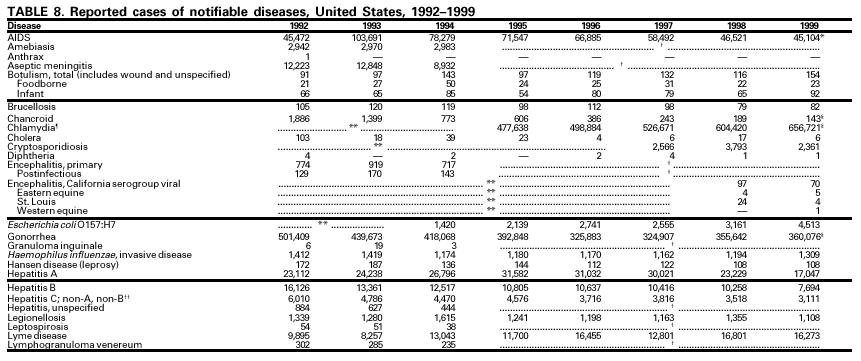
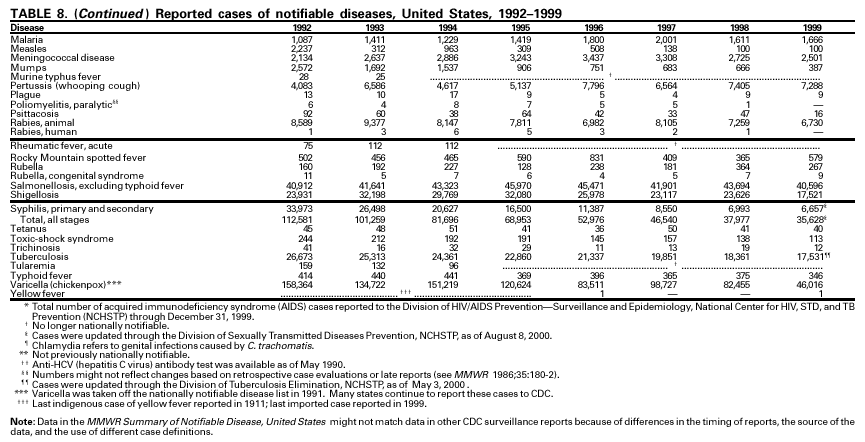
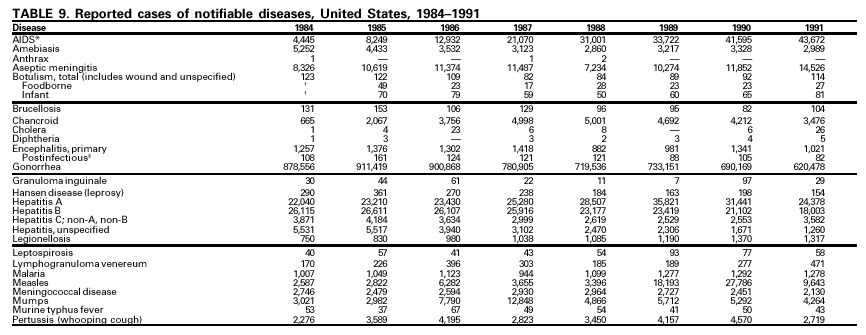
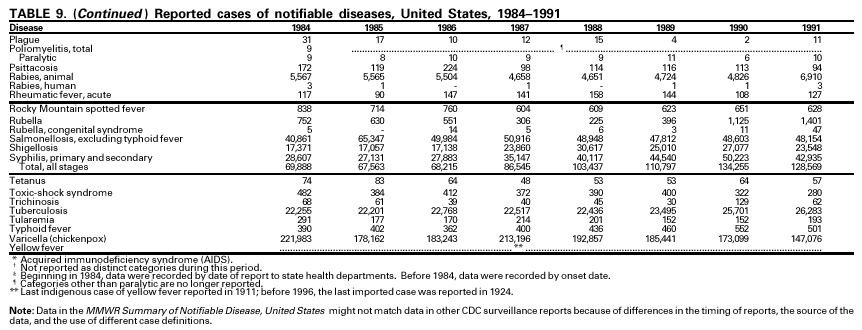
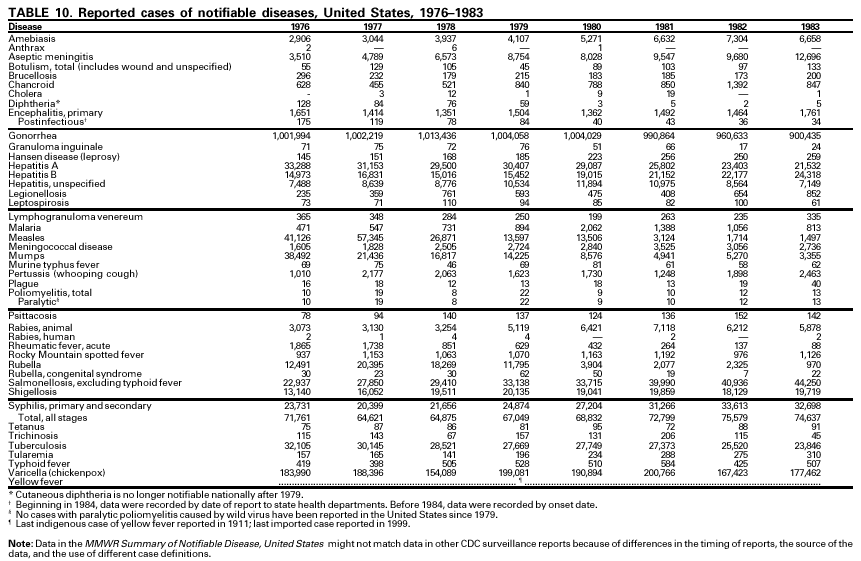
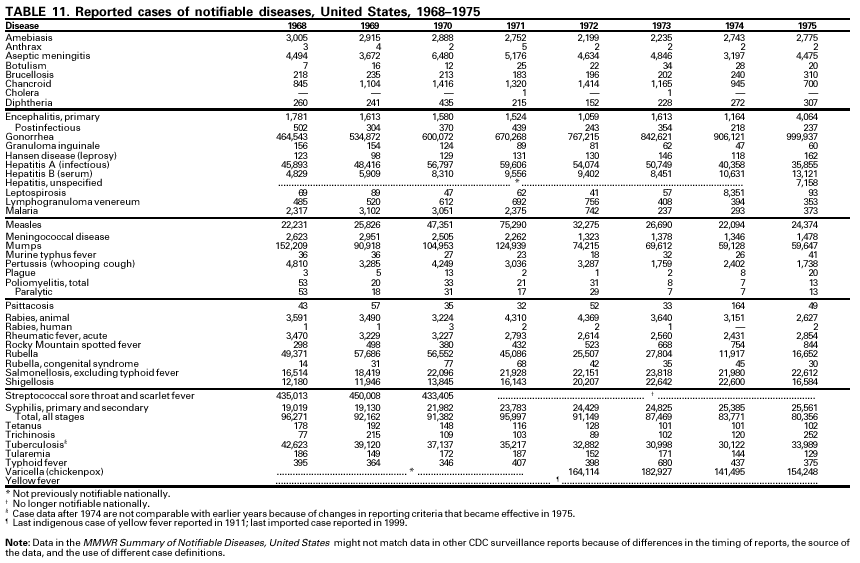
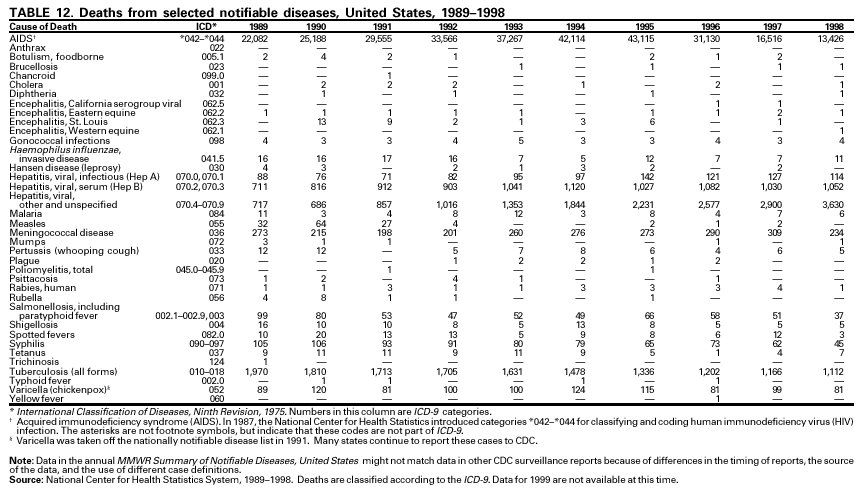
Selected ReadingGeneral Teutsch SM, Churchill RE, eds. Principles and practice of public health surveillance. 2nd ed. New York, NY: Oxford University Press, 2000. Chin JE, ed. Control of communicable diseases manual. 17th ed. Washington, DC: American Public Health Association, 2000. Effler P, Ching-Lee M, Bogard A, Ieong M-C, Nekomoto T, Jernigan D. Statewide system of electronic notifiable disease reporting from clinical laboratories: comparing automated reporting with conventional methods. JAMA 1999;282;1845--50. Available on the Internet at <http://jama.amaassn.org/issues/v282n19/full/joc90534.html>. Accessed August 3, 2000. Roush S, Birkhead G, Koo D, Cobb A, Fleming D. Mandatory reporting of diseases and conditions by health care professionals and laboratories. JAMA 1999;282:164--70. Available on the Internet at <http://jama.amaassn.org/issues/v282n2/rfull/joc90413.html>. Accessed November 21, 2000. Koo D, Caldwell B. The role of providers and health plans in infectious disease surveillance. Eff Clin Pract 1999;2:247--52. Available on the Internet at <http://www.acponline.org/journals/ecp/sepoct99/koo.htm>. Accessed August 3, 2000. CDC. Framework for program evaluation in public health. MMWR 1999;48(No. RR-11). Available on the Internet at <http://www.cdc.gov/mmwr/PDF/rr/rr4811.pdf>. Accessed November 21, 2000. CDC. Reporting race and ethnicity data---National Electronic Telecommunications System for Surveillance, 1994--1997. MMWR 1999;48:305--12. Available on the Internet at <http://www.cdc.gov/mmwr/PDF/wk/mm4815.pdf>. Accessed November 21, 2000. Niskar AS, Koo D. Differences in notifiable infectious disease morbidity among adult women---United States, 1992--1994. J Womens Health 1998;7:451--8. CDC. Case definitions for infectious conditions under public health surveillance. MMWR 1997;46(No. RR10). Available on the Internet at <http://www.cdc.gov/epo/dphsi/casedef/cover97.htm>. Accessed August 7, 2000. CDC. Sexually transmitted disease surveillance 1998. Atlanta, GA: US Department of Health and Human Services, Public Health Service, CDC, 1999. CDC. Manual for the surveillance of vaccinepreventable diseases. Atlanta, GA: CDC, 1999. Available on the Internet at <http://www.cdc.gov/nip/publications/surv-manual/begin.pdf>. Accessed August 8, 2000. CDC. Demographic differences in notifiable infectious disease morbidity---United States, 1992--1994. MMWR 1997;46:637--41. Available on the Internet at <ftp://ftp.cdc.gov/pub/Publications/mmwr/wk/mm4628.pdf>. Accessed November 21, 2000. CDC. Notifiable disease surveillance and notifiable disease statistics---United States, June 1946 and June 1996. MMWR 1996;45:530--6. Available on the Internet at <http://www.cdc.gov/mmwr/PDF/wk/mm4525.pdf>. Accessed November 21, 2000. Koo D, Wetterhall S. History and current status of the National Notifiable Diseases Surveillance System. J Public Health Manag Pract 1996;2:4--10. CDC. Ten leading nationally notifiable infectious diseases---United States, 1995. MMWR 1996;45:883--4. Available on the Internet at <http://www.cdc.gov/mmwr/PDF/wk/mm4541.pdf>. Accessed November 21, 2000. Martin SM, Bean NH. Data management issues for emerging diseases and new tools for managing surveillance and laboratory data. Emerg Infect Dis 1995;1:124--8. Available on the Internet at <http://www.cdc.gov/ncidod/eid/vol1no4/martin2.htm#top>. Accessed November 21, 2000. CDC. Manual of procedures for the reporting of nationally notifiable diseases to CDC. Atlanta, GA: US Department of Health and Human Services, Public Health Service, CDC, 1995. Thacker SB, Stroup DF. Future directions for comprehensive public health surveillance and health information systems in the United States. Am J Epidemiol 1994;140:383--97. CDC. Use of race and ethnicity in public health surveillance. MMWR 1993;42(No. RR10). Available on the Internet at <http://www.cdc.gov/mmwr/PDF/rr/rr4210.pdf>. Accessed November 21, 2000. CDC. Proceedings of the 1992 International Symposium on Public Health Surveillance. MMWR 1992;41(suppl). CDC. Mandatory reporting of infectious diseases by clinicians and mandatory reporting of occupational diseases by clinicians. MMWR 1990;39(No. RR9). Available on the Internet at <http://www.cdc.gov/mmwr/preview/mmwrhtml/00001665.htm> and <http://www.cdc.gov/mmwr/preview/mmwrhtml/00001666.htm>. Accessed November 21, 2000. Thacker SB, Choi K, Brachman PS. The surveillance of infectious diseases. JAMA 1983;249:1181--5. AIDS CDC. Guidelines for national human immunodeficiency virus case surveillance, including monitoring for human immunodeficiency virus infection and acquired immunodeficiency syndrome. MMWR 1999;48(RR-13). Available on the Internet at <http://www.cdc.gov/mmwr/PDF/rr/rr4813.pdf>. Accessed November 21, 2000. Hammer SM, Squires KE, Hughes MD, et al. A controlled trial of two nucleoside analogues plus indinavir in persons with human immunodeficiency virus infection and CD4 cell counts of 200 per cubic millimeter or less. AIDS Clinical Trials Group 320 Study Team. N Engl J Med 1997;337:725--33. Council of State and Territorial Epidemiologists. CSTE position statement ID-4: National HIV surveillance---addition to the National Public Health Surveillance System. Atlanta, GA: Council of State and Territorial Epidemiologists, 1997. Available on the Internet at <http://www.cste.org/ps1997/1997-Id-4.doc>. Accessed October 13, 2000. Anthrax CDC. Surveillance for adverse events associated with anthrax vaccination---U.S. Department of Defense, 1998--2000. MMWR 2000;49:341--5. Available on the Internet at <http://www.cdc.gov/mmwr/PDF/wk/mm4916.pdf>. Accessed November 21, 2000. Turnbull PC, Hugh-Jones ME, Cosivi O. World Health Organization activities on anthrax surveillance and control. J Appl Microbiol 1999;87:318--20. Inglesby TV, Henderson DA, Bartlett JG, et al. Anthrax as a biological weapon: medical and public health management [Review]. JAMA 1999;281:1735--44. Available on the Internet at <http://jama.amaassn.org/issues/v281n18/ffull/jst80027.html>. Accessed November 21, 2000. CDC. Bioterrorism alleging use of anthrax and interim guidelines for management---United States, 1998. MMWR 1999;48;69--74. Available on the Internet at <http://www.cdc.gov/mmwr/PDF/wk/mm4804.pdf>. Accessed November 21, 2000. Botulism Angulo FJ, Getz J, Taylor JP, et al. A large outbreak of botulism: the hazardous baked potato. J Infect Dis 1998;178:172--7. CDC. Botulism in the United States, 1899--1996: handbook for epidemiologists, clinicians, and laboratory workers. Atlanta, GA: US Department of Health and Human Services, Public Health Service, CDC, 1998. Available on the Internet at <http://www.cdc.gov/ncidod/dbmd/diseaseinfo/botulism.pdf>. Accessed September 25, 2000. Shapiro RL, Hatheway C, Becher J, Swerdlow D. Botulism surveillance and emergence response: a public health strategy for a global challenge. JAMA 1997;278:433--5. Brucellosis Yagupsky, P. Detection of brucellae in blood cultures. J Clin Microbiol 1999;37:3437--42. CDC. Human exposure to Brucella abortus strain RB51---Kansas, 1997. MMWR 1998;47:172--5. Available on the Internet at <ftp://ftp.cdc.gov/pub/Publications/mmwr/wk/mm4709.pdf>. Accessed November 21, 2000. Chomel BB, DeBess EE, Mangiamele DM, et al. Changing trends in the epidemiology of human brucellosis in California from 1973 to 1992: a shift toward foodborne transmission. J Infect Dis 1994;170:1216--23. Taylor JP, Perdue JN. The changing epidemiology of human brucellosis in Texas, 1977--1986. Am J Epidemiol 1989;130:160--5. Chancroid Mertz KJ, Weiss JB, Webb RM, et al. An investigation of genital ulcers in Jackson, Mississippi, with use of a multiplex polymerase chain reaction assay: high prevalence of chancroid and human immunodeficiency virus infection. J Infect Dis 1998;178:1060--6. Mertz KJ, Trees D, Levine WC, et al. Etiology of genital ulcers and prevalence of human immunodeficiency virus coinfection in 10 U.S. cities. The Genital Ulcer Disease Surveillance Group. J Infect Dis 1998;178:1795--8. DiCarlo RP, Armentor BS, Martin DH. Chancroid epidemiology in New Orleans men. J Infect Dis 1995;172:446--52. CDC. Chancroid---United States, 1981--1990: evidence for underreporting of cases. In: CDC surveillance summaries, May 29, 1992. MMWR 1992;41(No. SS-3):57--61. Chlamydia trachomatis, Genital Infection CDC. Sexually transmitted disease surveillance 1999 supplement: Chlamydia Prevalence Monitoring Project. Atlanta, GA: US Department of Health and Human Services, CDC, November 2000. Available on the Internet at <http://www.cdc.gov/nchstp/dstd/Stats_Trends/99Chlamydia.htm>. Accessed November 21, 2000. Gaydos CA, Howell MR, Pare B, et al. Chlamydia trachomatis infections in female military recruits. N Engl J Med 1998;339:739--44. Mertz KJ, McQuillan GM, Levine WC, et al. A pilot study of chlamydial infection in a national household survey. Sex Transm Dis 1998;25:225--8. CDC. Chlamydia trachomatis genital infections---United States, 1995. MMWR 1997;46:193--8. Available on the Internet at <ftp://ftp.cdc.gov/pub/Publications/mmwr/wk/mm4609.pdf>. Accessed November 21, 2000. Cholera Ackers ML, Quick RE, Drasbeck CJ, Hutwagner L, Tauxe RV. Are there national risk factors for epidemic cholera? The correlation between socioeconomic and demographic indices and cholera incidence in Latin America. Int J Epidemiol 1998;27:330--4. Mintz ED, Tauxe RV, Levine MM. The global resurgence of cholera. In: Noah ND, O'Mahony M, eds. Communicable disease epidemiology and control. Chichester, England: John Wiley & Sons, 1998:63--104. Mahon BE, Mintz ED, Greene KD, Wells JG, Tauxe RV. Reported cholera in the United States, 1992--1994: a reflection of global changes in cholera epidemiology. JAMA 1996;276:307--12. Wachsmuth IK, Blake PA, Olsvik O, eds. Vibrio cholerae and cholera: molecular to global perspectives. Washington, DC: American Society for Microbiology, 1994. World Health Organization. Guidelines for cholera control. Geneva, Switzerland: World Health Organization, 1993. Cryptosporidiosis Kramer MH, Herwaldt BL, Craun GF, Calderon RL, Juranek DD. Surveillance for waterbornedisease outbreaks---United States, 1993--1994. In: CDC surveillance summaries, April 12, 1996. MMWR 1996;45(No. SS-1). Available on the Internet at <http://www.cdc.gov/mmwr/PDF/ss/ss4501.pdf>. Accessed November 21, 2000. Juranek DD. Cryptosporidiosis: sources of infection and guidelines for prevention. Clin Infect Dis 1995;21(suppl 1):S57--S61. Also available on the Internet at the following site: <http://www.cdc.gov/ncidod/diseases/crypto/sources.htm>. Accessed September 27, 2000 CDC. Assessing the public health threat associated with waterborne cryptosporidiosis: report of a workshop. MMWR 1995;44(No. RR6). Also available on the Internet at <http://www.cdc.gov/mmwr/preview/ind95_rr.html>. Accessed September 27, 2000. Cyclosporiasis Herwaldt BL, Beach MJ. The return of Cyclospora in 1997: another outbreak of cyclosporiasis in North America associated with imported raspberries. Cyclospora Working Group. Ann Intern Med 1999;130:210--20. CDC. Outbreak of cyclosporiasis---Ontario, Canada, May 1998. MMWR 1998;47:806--9. Available on the Internet at <ftp://ftp.cdc.gov/pub/Publications/mmwr/wk/mm4738.pdf>. Accessed November 21, 2000. Herwaldt BL, Ackers ML. An outbreak in 1996 of cyclosporiasis associated with imported raspberries. The Cyclospora Working Group. N Engl J Med 1997;336:1548--56. Diphtheria Bisgard KM, Hardy IR, Popovic T, et al. Respiratory diphtheria in the United States, 1980 through 1995. Am J Public Health 1998;88:787--91. CDC. Respiratory diphtheria caused by Corynebacterium ulcerans---Terre Haute, Indiana, 1996. MMWR 1997:46:330--2. Available on the Internet at <ftp://ftp.cdc.gov/pub/Publications/mmwr/wk/mm4615.pdf>. Accessed November 21, 2000. Leek MD, Sivaloganathan S, Devaraj SK, Zamiri I, Griffiths GD, Green MA. Diphtheria with a difference---a rare corynebacterium fatality with associated apoptotic cell death. Histopathology 1990;16:187--9. Encephalitis, Arboviral (California Serogroup Viral, Eastern Equine, St. Louis, and Western Equine) Jones TF, Craig AS, Nasci RS, et al. Newly recognized focus of La Crosse encephalitis in Tennessee. Clin Infect Dis 1999;28:93--7. CDC. Arboviral infections of the central nervous system---United States, 1996--1997. MMWR 1998;47:517--22. Available on the Internet at <ftp://ftp.cdc.gov/pub/Publications/mmwr/wk/mm4725.pdf>. Accessed November 21, 2000. Szumlas DE, Apperson CS, Hartig PC, Francy DB, Karabatsos N. Seroepidemiology of La Crosse virus infection in humans in western North Carolina. Am J Trop Med Hyg 1996;54:332--7. Marfin AA, Bleed DM, Lofgren JP, et al. Epidemiologic aspects of a St. Louis encephalitis epidemic in Jefferson County, Arkansas, 1991. Am J Trop Med Hyg 1993;49:30--7. Escherichia coli O157:H7; Hemolytic Uremic Syndrome, Postdiarrheal CDC. PulseNet. The National Molecular Subtyping Network for Foodborne Disease Surveillance. Available on the Internet at <http://www.cdc.gov/ncidod/dbmd/pulsenet/pulsenet.htm>. Accessed August 30, 2000. Bender JB, Hedberg CW, Besser JM, Boxrud DJ, MacDonald KL, Osterholm MT. Surveillance for Escherichia coli O157:H7 infections in Minnesota by molecular subtyping. N Engl J Med 1997;337:388--94. Mahon BE, Griffin PM, Mead PS, Tauxe RV. Hemolytic uremic syndrome surveillance to monitor trends in infection with Escherichia coli O157:H7 and other shiga toxinproducing E. coli. Emerg Infect Dis 1997;3:409--12. Available on the Internet at <http://www.cdc.gov/ncidod/eid/vol3no3/letters.htm#mahon>. Accessed November 21, 2000. Slutsker L, Ries AA, Greene KD, Wells JG, Hutwagner L, Griffin PM. Escherichia coli O157:H7 diarrhea in the United States: clinical and epidemiologic features. Ann Intern Med 1997;126:505--13. Ehrlichiosis (Human Granulocytic and Human Monocytic) IJdo JW, Meek JI, Cartter ML, et al. The emergence of another tickborne infection in the 12-town area around Lyme, Connecticut: human granulocytic ehrlichiosis. J Infect Dis 2000;181:1388--93. McQuiston JH, Paddock CD, Holman RC, Childs JE. The human ehrlichioses in the United States [Review]. Emerg Infect Dis 1999;5:635--42. Available on the Internet at <http://www.cdc.gov/ncidod/eid/vol5no5/mcquiston.htm>. Accessed November 21, 2000. Childs JE, Sumner JW, Nicholson WL, Massung RF, Standaert SM, Paddock CD. Outcome of diagnostic tests using samples from patients with culture-proven human monocytic ehrlichiosis: implications for surveillance. J Clin Microbiol 1999;37:2997--3000. Gonorrhea CDC. Sexually transmitted diseases surveillance 1999 supplement: Gonococcal Isolate Surveillance Project (GISP) annual report --1999. Atlanta, GA: US Department of Health and Human Services, CDC, November 2000. Available on the Internet at <http://www.cdc.gov/nchstp/dstd/Stats_Trends/99GISP.htm>. Accessed November 21, 2000. CDC. Gonorrhea---United States, 1998. MMWR 2000;49:538--42. Available on the Internet at <http://www.cdc.gov/mmwr/PDF/wk/mm4924.pdf>. Accessed November 21, 2000. CDC. Increases in unsafe sex and rectal gonorrhea among men who have sex with men---San Francisco, California, 1994--1997. MMWR 1999;48:45--8. Available on the Internet at <http://www.cdc.gov/mmwr/PDF/wk/mm4803.pdf>. Accessed November 21, 2000. Haemophilus influenzae, Invasive Disease Galil K, Singleton R, Levine OS, et al. Reemergence of invasive Haemophilus influenzae type b disease in a well-vaccinated population in remote Alaska. J Infect Dis 1999;179:101--6. Bisgard KM, Kao A, Leake J, Strebel PM, Perkins BA, Wharton M. Haemophilus influenzae invasive disease in the United States, 1994--1995: near disappearance of a vaccine-preventable childhood disease. Emerg Infect Dis 1998;2:229--37. Available on the Internet at <http://www.cdc.gov/ncidod/eid/vol4no2/bisgard.htm>. Accessed November 21, 2000. CDC. Progress toward eliminating Haemophilus influenzae type b disease among infants and children---United States, 1987--1997. MMWR 1998;47:993--8. Available on the Internet at <ftp://ftp.cdc.gov/pub/Publications/mmwr/wk/mm4746.pdf>. Accessed November 21, 2000. CDC. Recommendations for use of Haemophilus b conjugate vaccines and a combined diphtheria, tetanus, pertussis, and Haemophilus b vaccine: recommendations of the Advisory Committee on Immunization Practices (ACIP). MMWR 1993;42(No. RR-13). Available on the Internet at <http://www.cdc.gov/mmwr/PDF/rr/rr4213.pdf>. Accessed November 21, 2000. Hantavirus Pulmonary Syndrome CDC. Hantavirus Pulmonary Syndrome---Panama, 1999--2000. MMWR 2000;49:205--7. Available on the Internet at <http://www.cdc.gov/mmwr/PDF/wk/mm4910.pdf>. Accessed November 21, 2000. Kitsutani PI, Denton RW, Fritz CL, et al. Acute Sin Nombre hantavirus infection without pulmonary syndrome, United States. Emerg Infect Dis 1999;5:701--5. Available on the Internet at <http://www.cdc.gov/ncidod/eid/vol5no5/kitsutani.htm>. Accessed November 21, 2000. Monroe MC, Morzunov SP, Johnson AM, et al. Genetic diversity and distribution of Peromyscus-borne hantaviruses in North America. Emerg Infect Dis 1999;5:75--86. Available on the Internet at <http://www.cdc.gov/ncidod/eid/vol5no1/monroe.htm>. Accessed November 21, 2000. Zavasky D-M, Hjelle B, Peterson M, et al. Acute infection with Sin Nombre hantavirus without pulmonary edema. Clin Infect Dis 1999;29:664--6. Hepatitis A CDC. Prevention of hepatitis A through active or passive immunization: recommendations of the Advisory Committee on Immunization Practices (ACIP). MMWR 1999;48(No. RR12). Available on the Internet at <http://www.cdc.gov/mmwr/PDF/rr/rr4812.pdf>. Accessed November 21, 2000. Bell BP, Shapiro CN, Alter MJ, et al. The diverse patterns of hepatitis A epidemiology in the United States---implications for vaccination strategies. J Infect Dis 1998;178:1579--84. Lemon SM, Shapiro CN. The value of immunization against hepatitis A. Infect Agents Dis 1994;3:38--49. Shapiro CN, Coleman PJ, McQuillan GM, Alter MJ, Margolis HS. Epidemiology of hepatitis A: seroepidemiology and risk groups in the USA. Vaccine 1992;10(suppl 1):S59--S62. CDC. Outbreak of cyclosporiasis---Ontario, Canada, May 1998. MMWR 1998;47:806--9. Available on the Internet at <ftp://ftp.cdc.gov/pub/Publications/mmwr/wk/mm4738.pdf>. Accessed November 21, 2000. Herwaldt BL, Ackers ML. An outbreak in 1996 of cyclosporiasis associated with imported raspberries. The Cyclospora Working Group. N Engl J Med 1997;336:1548--56. Diphtheria Bisgard KM, Hardy IR, Popovic T, et al. Respiratory diphtheria in the United States, 1980 through 1995. Am J Public Health 1998;88:787--91. CDC. Respiratory diphtheria caused by Corynebacterium ulcerans---Terre Haute, Indiana, 1996. MMWR 1997:46:330--2. Available on the Internet at <ftp://ftp.cdc.gov/pub/Publications/mmwr/wk/mm4615.pdf>. Accessed November 21, 2000. Leek MD, Sivaloganathan S, Devaraj SK, Zamiri I, Griffiths GD, Green MA. Diphtheria with a difference---a rare corynebacterium fatality with associated apoptotic cell death. Histopathology 1990;16:187--9. Encephalitis, Arboviral (California Serogroup Viral, Eastern Equine, St. Louis, and Western Equine) Jones TF, Craig AS, Nasci RS, et al. Newly recognized focus of La Crosse encephalitis in Tennessee. Clin Infect Dis 1999;28:93--7. CDC. Arboviral infections of the central nervous system---United States, 1996--1997. MMWR 1998;47:517--22. Available on the Internet at <ftp://ftp.cdc.gov/pub/Publications/mmwr/wk/mm4725.pdf>. Accessed November 21, 2000. Szumlas DE, Apperson CS, Hartig PC, Francy DB, Karabatsos N. Seroepidemiology of La Crosse virus infection in humans in western North Carolina. Am J Trop Med Hyg 1996;54:332--7. Marfin AA, Bleed DM, Lofgren JP, et al. Epidemiologic aspects of a St. Louis encephalitis epidemic in Jefferson County, Arkansas, 1991. Am J Trop Med Hyg 1993;49:30--7. Escherichia coli O157:H7; Hemolytic Uremic Syndrome, Postdiarrheal CDC. PulseNet. The National Molecular Subtyping Network for Foodborne Disease Surveillance. Available on the Internet at <http://www.cdc.gov/ncidod/dbmd/pulsenet/pulsenet.htm>. Accessed August 30, 2000. Bender JB, Hedberg CW, Besser JM, Boxrud DJ, MacDonald KL, Osterholm MT. Surveillance for Escherichia coli O157:H7 infections in Minnesota by molecular subtyping. N Engl J Med 1997;337:388--94. Mahon BE, Griffin PM, Mead PS, Tauxe RV. Hemolytic uremic syndrome surveillance to monitor trends in infection with Escherichia coli O157:H7 and other shiga toxinproducing E. coli. Emerg Infect Dis 1997;3:409--12. Available on the Internet at <http://www.cdc.gov/ncidod/eid/vol3no3/letters.htm#mahon>. Accessed November 21, 2000. Slutsker L, Ries AA, Greene KD, Wells JG, Hutwagner L, Griffin PM. Escherichia coli O157:H7 diarrhea in the United States: clinical and epidemiologic features. Ann Intern Med 1997;126:505--13. Ehrlichiosis (Human Granulocytic and Human Monocytic) IJdo JW, Meek JI, Cartter ML, et al. The emergence of another tickborne infection in the 12-town area around Lyme, Connecticut: human granulocytic ehrlichiosis. J Infect Dis 2000;181:1388--93. McQuiston JH, Paddock CD, Holman RC, Childs JE. The human ehrlichioses in the United States [Review]. Emerg Infect Dis 1999;5:635--42. Available on the Internet at <http://www.cdc.gov/ncidod/eid/vol5no5/mcquiston.htm>. Accessed November 21, 2000. Childs JE, Sumner JW, Nicholson WL, Massung RF, Standaert SM, Paddock CD. Outcome of diagnostic tests using samples from patients with culture-proven human monocytic ehrlichiosis: implications for surveillance. J Clin Microbiol 1999;37:2997--3000. Gonorrhea CDC. Sexually transmitted diseases surveillance 1999 supplement: Gonococcal Isolate Surveillance Project (GISP) annual report --1999. Atlanta, GA: US Department of Health and Human Services, CDC, November 2000. Available on the Internet at <http://www.cdc.gov/nchstp/dstd/Stats_Trends/99GISP.htm>. Accessed November 21, 2000. CDC. Gonorrhea---United States, 1998. MMWR 2000;49:538--42. Available on the Internet at <http://www.cdc.gov/mmwr/PDF/wk/mm4924.pdf>. Accessed November 21, 2000. CDC. Increases in unsafe sex and rectal gonorrhea among men who have sex with men---San Francisco, California, 1994--1997. MMWR 1999;48:45--8. Available on the Internet at <http://www.cdc.gov/mmwr/PDF/wk/mm4803.pdf>. Accessed November 21, 2000. Haemophilus influenzae, Invasive Disease Galil K, Singleton R, Levine OS, et al. Reemergence of invasive Haemophilus influenzae type b disease in a well-vaccinated population in remote Alaska. J Infect Dis 1999;179:101--6. Bisgard KM, Kao A, Leake J, Strebel PM, Perkins BA, Wharton M. Haemophilus influenzae invasive disease in the United States, 1994--1995: near disappearance of a vaccine-preventable childhood disease. Emerg Infect Dis 1998;2:229--37. Available on the Internet at <http://www.cdc.gov/ncidod/eid/vol4no2/bisgard.htm>. Accessed November 21, 2000. CDC. Progress toward eliminating Haemophilus influenzae type b disease among infants and children---United States, 1987--1997. MMWR 1998;47:993--8. Available on the Internet at <ftp://ftp.cdc.gov/pub/Publications/mmwr/wk/mm4746.pdf>. Accessed November 21, 2000. CDC. Recommendations for use of Haemophilus b conjugate vaccines and a combined diphtheria, tetanus, pertussis, and Haemophilus b vaccine: recommendations of the Advisory Committee on Immunization Practices (ACIP). MMWR 1993;42(No. RR-13). Available on the Internet at <http://www.cdc.gov/mmwr/PDF/rr/rr4213.pdf>. Accessed November 21, 2000. Hantavirus Pulmonary Syndrome CDC. Hantavirus Pulmonary Syndrome---Panama, 1999--2000. MMWR 2000;49:205--7. Available on the Internet at <http://www.cdc.gov/mmwr/PDF/wk/mm4910.pdf>. Accessed November 21, 2000. Kitsutani PI, Denton RW, Fritz CL, et al. Acute Sin Nombre hantavirus infection without pulmonary syndrome, United States. Emerg Infect Dis 1999;5:701--5. Available on the Internet at <http://www.cdc.gov/ncidod/eid/vol5no5/kitsutani.htm>. Accessed November 21, 2000. Monroe MC, Morzunov SP, Johnson AM, et al. Genetic diversity and distribution of Peromyscus-borne hantaviruses in North America. Emerg Infect Dis 1999;5:75--86. Available on the Internet at <http://www.cdc.gov/ncidod/eid/vol5no1/monroe.htm>. Accessed November 21, 2000. Zavasky D-M, Hjelle B, Peterson M, et al. Acute infection with Sin Nombre hantavirus without pulmonary edema. Clin Infect Dis 1999;29:664--6. Hepatitis A CDC. Prevention of hepatitis A through active or passive immunization: recommendations of the Advisory Committee on Immunization Practices (ACIP). MMWR 1999;48(No. RR12). Available on the Internet at <http://www.cdc.gov/mmwr/PDF/rr/rr4812.pdf>. Accessed November 21, 2000. Bell BP, Shapiro CN, Alter MJ, et al. The diverse patterns of hepatitis A epidemiology in the United States---implications for vaccination strategies. J Infect Dis 1998;178:1579--84. Lemon SM, Shapiro CN. The value of immunization against hepatitis A. Infect Agents Dis 1994;3:38--49. Shapiro CN, Coleman PJ, McQuillan GM, Alter MJ, Margolis HS. Epidemiology of hepatitis A: seroepidemiology and risk groups in the USA. Vaccine 1992;10(suppl 1):S59--S62. Hepatitis B McQuillan GM, Coleman PJ, Kruszon-Moran D, Moyer LA, Lambert SB, Margolis HS. Prevalence of hepatitis B virus infection in the United States: The National Health and Nutrition Examination Surveys, 1976 through 1994. Am J Pub Health 1999;89:14--8. Coleman PJ, McQuillan GM, Moyer LA, Lambert SB, Margolis HS. Incidence of hepatitis B virus infection in the United States, 1976--1994: estimates from the National Health and Nutrition Examination Surveys. J Infect Dis 1998;178:954--9. Margolis HS, Alter MJ, Hadler SC. Hepatitis B: evolving epidemiology and implications for control [Review]. Semin Liver Dis 1991;11:84--92. CDC. Hepatitis B virus: a comprehensive strategy for eliminating transmission in the United States through universal childhood vaccination: recommendations of the Immunization Practices Advisory Committee (ACIP). MMWR 1991;40(No. RR13):1--19. Available on the Internet at <http://www.cdc.gov/mmwr/preview/mmwrhtml/00033405.htm>. Accessed November 21, 2000. Hepatitis C; Non-A, Non-B Alter MJ, Kruszon-Moran D, Nainan OV, et al. The prevalence of hepatitis C virus infection in the United States, 1988 through 1994. N Engl J Med 1999;341:556--62. CDC. Recommendations for prevention and control of hepatitis C virus (HCV) infection and HCVrelated chronic disease. MMWR 1998;47(No. RR19). Available on the Internet at <http://www.cdc.gov/mmwr/PDF/rr/rr4719.pdf>. Accessed November 21, 2000. HIV Infection, Adult and Pediatric CDC. Guidelines for national human immunodeficiency virus case surveillance, including monitoring for human immunodeficiency virus infection and acquired immunodeficiency syndrome. MMWR 1999;48(No. RR-13). Available on the Internet at <http://www.cdc.gov/mmwr/PDF/rr/rr4813.pdf>. Accessed November 21, 2000. Lindegren ML, Byers RH, Jr., Thomas P, et al. Trends in perinatal transmission of HIV/AIDS in the United States. JAMA 1999;282:531--8. Available on the Internet at <http://jama.amaassn.org/issues/v282n6/rfull/joc81248.html>. Accessed November 21, 2000. CDC. HIV/AIDS surveillance report, 1999;11(No. 2). Available on the Internet at <http://www.cdc.gov/hiv/stats/hasr1102.htm>. Accessed September 25, 2000. CDC. Success in implementing Public Health Service guidelines to reduce perinatal transmission of HIV --- Louisiana, Michigan, New Jersey, and South Carolina, 1993, 1995, and 1996. MMWR 1998;47:688--91. Available on the Internet at <ftp://ftp.cdc.gov/pub/Publications/mmwr/wk/mm4733.pdf>. Accessed November 21, 2000. Legionellosis Kool JL, Carpenter JC, Fields BS. Effect of monochloramine disinfection of municipal drinking water on risk of nosocomial Legionnaires' disease. Lancet 1999;353:272--7. Fiore AE, Butler JC, Emori TG, Gaynes RP. A survey of methods used to detect nosocomial legionellosis among participants in the National Nosocomial Infections Surveillance System. Infect Control Hosp Epidemiol 1999;20:412--6. Kool JL, Bergmire-Sweat D, Butler JC, et al. Hospital characteristics associated with colonization of water systems by Legionella and risk of nosocomial legionnaires' disease: a cohort study of 15 hospitals. Infect Control Hosp Epidemiol 1999;20:798--805. Marston BJ, Lipman HB, Breiman RF. Surveillance for Legionnaires' disease. Risk factors for morbidity and mortality. Arch Intern Med 1994;154:2417--22. Lyme Disease Orloski KA, Hayes EB, Campbell GL, Dennis DT. Surveillance for Lyme disease --- United States, 1992--1998. In: CDC surveillance summaries, April 28, 2000. MMWR 2000;49(No. SS-3):1--11. Available on the Internet at <http://www.cdc.gov/mmwr/PDF/ss/ss4903.pdf>. Accessed November 21, 2000. Hayes EB, Maupin GO, Mount GA, Piesman J. Assessing the prevention effectiveness of local Lyme disease control. J Public Health Manag Pract 1999;5:84--92. CDC. Recommendations for the use of Lyme disease vaccine: recommendations of the Advisory Committee on Immunization Practices (ACIP). MMWR 1999;48(No. RR-7). Available on the Internet at <http://www.cdc.gov/mmwr/PDF/rr/rr4807.pdf>. Accessed November 21, 2000. Dennis DT. Epidemiology, ecology, and prevention of Lyme disease. In: Rahn D, Evans J, eds. Lyme disease. Philadelphia, PA: American College of Physicians, 1998:7--34. Malaria Lobel HO, Kozarsky PE. Update on prevention of malaria for travelers. JAMA 1997;278:1767--71. Zucker JR. Changing patterns of autochthonous malaria transmission in the United States: a review of recent outbreaks. Emerg Infect Dis 1996;2:37--43. Available on the Internet at <http://www.cdc.gov/ncidod/eid/vol2no1/zuckerei.htm>. Accessed November 21, 2000. Zucker JR, Campbell CC. Malaria. Principles of prevention and treatment [Review]. Infect Dis Clin North Am 1993;7:547--67. Measles CDC. Measles --- United States, 1999. MMWR 2000:49:557--60. Available on the Internet at <http://www.cdc.gov/mmwr/PDF/wk/mm4925.pdf>. Accessed November 21, 2000. CDC. Epidemiology of measles --- United States, 1998. MMWR 1999:48:749--53. Available on the Internet at <http://www.cdc.gov/mmwr/PDF/wk/mm4834.pdf>. Accessed November 21, 2000. CDC. Measles --- United States, 1997. MMWR 1998:47:273--6. Available on the Internet at <ftp://ftp.cdc.gov/pub/Publications/mmwr/wk/mm4714.pdf>. Accessed November 21, 2000. CDC. Measles, mumps and rubella --- vaccine use and strategies for elimination of measles, rubella, and congenital rubella syndrome and control of mumps: recommendations of the Advisory Committee on Immunization Practices (ACIP). MMWR 1998:47(No. RR-8). Available on the Internet at <http://www.cdc.gov/mmwr/PDF/rr/rr4708.pdf>. Accessed November 21, 2000. Meningococcal Disease CDC. Prevention and control of meningococcal disease, and meningococal disease and college students: recommendations of the Advisory Committee on Immunization Practices (ACIP). MMWR 2000;49(No. RR-7). Available on the Internet at <http://www.cdc.gov/mmwr/PDF/rr/rr4907.pdf>. Accessed November 21, 2000. CDC. Serogroup W-135 meningococcal disease among travelers returning from Saudi Arabia --- United States, 2000. MMWR 2000;49:345--6. Available on the Internet at <http://www.cdc.gov/mmwr/PDF/wk/mm4916.pdf>. Accessed November 21, 2000. Rosenstein NE, Perkins BA, Stephens DS, et al. The changing epidemiology of meningococcal disease in the United States, 1992--1996. J Infect Dis 1999;180:1894--901. Diermayer M, Hedberg K, Hoesly FC, et al. Epidemic serogroup B meningococcal disease in Oregon: the evolving epidemiology of the ET-5 strain. JAMA 1999;281:1493--7. Available on the Internet at <http://jama.amaassn.org/issues/v281n16/rfull/joc81215.html>. Accessed November 21, 2000. Mumps CDC. Mumps surveillance --- United States, 1988--1993. In: CDC surveillance summaries, August 11, 1995. MMWR 1995;44(No. SS-3). Available on the Internet at <http://www.cdc.gov/mmwr/PDF/ss/ss4403.pdf>. Accessed November 21, 2000. Briss PA, Fehrs LJ, Parker RA, et al. Sustained transmission of mumps in a highly vaccinated population: assessment of primary vaccine failure and waning vaccine-induced immunity. J Infect Dis 1994;169:77--82. Hersh BS, Fine PE, Kent WK, et al. Mumps outbreak in a highly vaccinated population. J Pediatr 1991;119:187--93. CDC. Recommendations of the Immunization Practices Advisory Committee on Mumps prevention. MMWR 1989;38:388--92, 397--400. Available on the Internet at <http://www.cdc.gov/mmwr/preview/mmwrhtml/00001404.htm>. Accessed November 21, 2000. Pertussis Guris D, Strebel PM, Bardenheier B, et al. Changing epidemiology of pertussis in the United States: increasing reported incidence among adolescents and adults, 1990--1996. Clin Infect Dis 1999;28:1230--7. CDC. Notice to readers: FDA approval of a fourth acellular pertussis vaccine for use among infants and young children. MMWR 1998;47:934--6. Available on the Internet at <ftp://ftp.cdc.gov/pub/Publications/mmwr/wk/mm4743.pdf>. Accessed November 21, 2000. CDC. Pertussis vaccination: use of acellular pertussis vaccines among infants and young children. Recommendations of the Advisory Committee on Immunization Practices (ACIP). MMWR 1997;46(No.RR-7). Available on the Internet at <http://www.cdc.gov/mmwr/PDF/rr/rr4607.pdf>. Accessed November 21, 2000. Plague Inglesby TV, Dennis DT, Henderson DA, et al. Plague as a biological weapon: medical and public health management. Working Group on Civilian Biodefense [Review]. JAMA 2000;283:2281--90. Dennis DT, Gage KL, Gratz N, Poland JD, Tikhomirov E. Plague manual: epidemiology, distribution, surveillance and control. Geneva, Switzerland: World Health Organization, 1999. Poland JD, Dennis DT. Plague. In: Evans AS, Brachman PS, eds. Bacterial infections of humans: epidemiology and control. 3rd ed. New York, NY: Plenum Medical Book Company, 1998:545--58. Poliomyelitis, Paralytic CDC. Poliomyelitis prevention in the United States: updated recommendations of the Advisory Committee on Immunization Practices (ACIP). MMWR 2000;49(No. RR-5). Available on the Internet at <http://www.cdc.gov/mmwr/PDF/rr/rr4905.pdf>. Accessed November 21, 2000. Prevots DR, Khetsuriani N, Wharton M. Evidence for a decline in the number of vaccine-associated paralytic poliomyelitis cases in the United States following implementation of a sequential poliovirus vaccination schedule, 1997--1998. Presented at the 36th annual meeting of the Infectious Disease Society of America, November 12--15, 1998. Prevots DR, Sutter RW, Strebel PM, Weibel RE, Cochi SL. Completeness of reporting for paralytic poliomyelitis, United States, 1980 through 1991. Implications for estimating the risk of vaccine-associated disease. Arch Pediatr Adolesc Med 1994;148:479--85. Psittacosis CDC. Compendium of measures to control Chyamydia psittaci among humans (psittacosis) and pet birds (avian chlamydiosis), 2000. MMWR 2000;49(No. RR-8):1--17. Available on the Internet at <http://www.cdc.gov/mmwr/PDF/rr/rr4908.pdf>. Accessed November 21, 2000. Moroney JF, Guevara R, Iverson C, et al. Detection of chlamydiosis in a shipment of pet birds, leading to recognition of an outbreak of clinically mild psittacosis in humans. Clin Infect Dis 1998;26:1425--9. Jorgensen DM. Gestational psittacosis in a Montana sheep rancher. Emerg Infect Dis 1997;2:191--4. Available on the Internet at <http://www.cdc.gov/ncidod/eid/vol3no2/jorgen.htm>. Accessed November 21, 2000. Wong KH, Skelton SK, Daugharty H. Utility of complement fixation and microimmunofluorescence assays for detecting serologic responses in patients with clinically diagnosed psittacosis. J Clin Microbiol 1994;32:2417--21. Rabies, Animal and Human CDC. Compendium of animal rabies prevention and control, 2000: National Association of State and Territorial Public Health Veterinarians, Inc. MMWR 2000;49(No. RR-8):19--30. Available on the Internet at <http://www.cdc.gov/mmwr/PDF/rr/rr4908.pdf>. Accessed November 21, 2000. CDC. Human rabies prevention---United States, 1999: recommendations of the Advisory Committee on Immunization Practices (ACIP). MMWR 1999;48(No. RR-1). Available on the Internet at <http://www.cdc.gov/mmwr/PDF/rr/rr4801.pdf>. Accessed November 21, 2000. Krebs JW, Smith JS, Rupprecht CE, Childs JE. Rabies surveillance in the United States during 1998. J Am Vet Med Assoc 1999;215:1786--98. Noah DL, Drenzek CL, Smith JS, et al. Epidemiology of human rabies in the United States, 1980 to 1996 [Review]. Ann Intern Med 1998;128:922--30. Rocky Mountain Spotted Fever Paddock CD, Greer PW, Ferebee TL, et al. Hidden mortality attributable to Rocky Mountain spotted fever: immunohistochemical detection of fatal, serologically unconfirmed diseases. J Infect Dis 1999;179:1469--76. Thorner AR, Walker DH, Petri WA, Jr. Rocky Mountain spotted fever [Review]. Clin Infect Dis 1998;27:1353--9. Dalton MJ, Clarke MJ, Holman RC, et al. National surveillance for Rocky Mountain spotted fever, 1981--1992: epidemiologic summary and evaluation of risk factors for fatal outcome. Am J Trop Med Hyg 1995;52:405--13. Rubella and Rubella, Congenital Syndrome Reef SE, Plotkin S, Cordero JF, et al. Preparing for elimination of Congenital Rubella Syndrome (CRS): summary of a workshop on CRS elimination in the United States. Clin Infect Dis 2000;31:85--95. CDC. Rubella among Hispanic adults---Kansas, 1998, and Nebraska, 1999. MMWR 2000;49:225--8. Available on the Internet at <http://www.cdc.gov/mmwr/PDF/wk/mm4911.pdf>. Accessed November 21, 2000. CDC. Rubella outbreak---Westchester County, New York, 1997--1998. MMWR 1999;48:560--3. Available on the Internet at <http://www.cdc.gov/mmwr/PDF/wk/mm4826.pdf>. Accessed November 21, 2000. Salmonellosis Van Beneden CA, Keene WE, Strang RA, et al. Multinational outbreak of Salmonella enterica serotype Newport infections due to contaminated alfalfa sprouts. JAMA 1999;281:158--62. Available on the Internet at <http://jama.amaassn.org/issues/v281n2/rfull/joc80937.html>. Accessed December 8, 2000. Mahon BE, Slutsker L, Hutwagner L, et al. Consequences in Georgia of a nationwide outbreak of Salmonella infections: what you don't know might hurt you. Am J Public Health 1999;89:31--5. Glynn MK, Bopp C, Dewitt WK, Dabney P, Mokhtar M, Angulo FJ. Emergence of multidrug-resistant Salmonella enterica serotype typhimurium DT104 infections in the United States. N Engl J Med 1998;338:1333--8. CDC. Multistate outbreak of Salmonella serotype Agona infections linked to toasted oats cereal---United States, April--May, 1998. MMWR 1998;47:462--4. Available on the Internet at <ftp://ftp.cdc.gov/pub/Publications/mmwr/wk/mm4722.pdf>. Accessed November 21, 2000. Shigellosis CDC. Outbreak of gastroenteritis associated with an interactive water fountain at a beachside park---Florida, 1999. MMWR 2000;49:565--8. Available on the Internet at <http://www.cdc.gov/mmwr/PDF/wk/mm4925.pdf>. Accessed November 21, 2000. CDC. Outbreaks of Shigella sonnei infection associated with eating fresh parsley---United States and Canada, July--August 1998. MMWR 1999;48:285--9. Available on the Internet at <http://www.cdc.gov/mmwr/PDF/wk/mm4814.pdf>. Accessed November 21, 2000. Sobel J, Cameron DN, Ismail J, et al. A prolonged outbreak of Shigella sonnei infections in traditionally observant Jewish communities in North America caused by a molecularly distinct bacterial subtype. J Infect Dis 1998;177:1405--8. Mohle-Boetani JC, Stapleton M, Finger R, et al. Communitywide shigellosis: control of an outbreak and risk factors in child day-care centers. Am J Public Health 1995;85:812--6. Streptococcal Disease, Invasive, Group A CDC. Noscomial group A streptococcal infections associated with asymptomatic healthcare workers---Maryland and California, 1997. MMWR 1999;48:163--6. Available on the Internet at <http://www.cdc.gov/mmwr/PDF/wk/mm4808.pdf>. Accessed November 21, 2000. Anonymous. Prevention of invasive group A streptococcal disease among household contacts of casepatients: is prophylaxis warranted? The Working Group on Prevention of Invasive Group A Streptococcal Infections. JAMA 1998;279:1206--10. Davies HD, McGeer A, Schwartz B, et al, and the Ontario Group A Streptococcal Study Group. Invasive group A streptococcal infections in Ontario, Canada.. N Engl J Med 1996;335:547--54. Anonymous. Defining the group A streptococcal toxic shock syndrome: rationale and consensus definition. The Working Group on Severe Streptococcal Infections. JAMA 1993;269:390--1. Streptococcus pneumoniae, Drug-Resistant, Invasive Disease CDC. Active Bacterial Core Surveillance. National Center for Infectious Diseases. Available at <http://www.cdc.gov/ncidod/dbmd/abcs>. Accessed June 23, 2000. Dowell SF, Butler JC, Giebink GS, et al. Acute otitis media: management and surveillance in an era of pneumococcal resistance---a report from the Drug-Resistant Streptococcus pneumoniae Therapeutic Working Group. Pediatr Infect Dis J 1999;18:1--9. Dowell SF. Principles of judicious use of antimicrobial agents for pediatric upper respiratory tract infections. Pediatrics 1998;101(suppl):S163--S184. CDC. Defining the public health impact of drug-resistant Streptococcus pneumoniae: report of a working group. MMWR 1996;45(No. RR-1). Available on the Internet at <http://www.cdc.gov/mmwr/PDF/rr/rr4501.pdf>. Accessed November 21, 2000. Syphilis, Congenital Southwick KL, Guidry HM, Weldon MM, Mertz KJ, Berman SM, Levine WC. An epidemic of congenital syphilis in Jefferson County, Texas, 1994--1995: inadequate prenatal syphilis testing after an outbreak in adults. Am J Public Health 1999;89:557--60. CDC. Congenital syphilis---United States, 1998. MMWR 1999;48:757--61. Available on the Internet at <http://www.cdc.gov/mmwr/PDF/wk/mm4834.pdf>. Accessed November 21, 2000. CDC. Guidelines for the prevention and control of congenital syphilis. MMWR 1988;37(No. S-1). Available on the Internet at <http://www.cdc.gov/mmwr/preview/mmwrhtml/00026330.htm>. Accessed November 21, 2000. Syphilis, Primary and Secondary CDC. Sexually transmitted disease surveillance supplement 1999: syphilis surveillance report. Atlanta, GA: US Department of Health and Human Services, CDC, November 2000. Available on the Internet at <http://www.cdc.gov/nchstp/dstd/Stats_Trends/99Syphilis.htm>. Accessed November 21, 2000. CDC. The National Plan to Eliminate Syphilis from the United States. Atlanta, GA: US Department of Health and Human Services, CDC, National Center for HIV, STD, and TB Prevention, October 1999. CDC. Primary and secondary syphilis---United States, 1998. MMWR 1999;48:873--8. Available on the Internet at <http://www.cdc.gov/mmwr/PDF/wk/mm4839.pdf>. Accessed November 21, 2000. CDC. Resurgent bacterial sexually transmitted disease among men who have sex with men---King County, Washington, 1997--1999. MMWR 1999;48:773--7. Available on the Internet at <http://www.cdc.gov/mmwr/PDF/wk/mm4835.pdf>. Accessed November 21, 2000. Tetanus Bardenheier B, Prevots DR, Khetsuriani N, Wharton M. Tetanus surveillance---United States, 1995--1997. In: CDC surveillance summaries, July 3, 1998. MMWR 1998;47(No. SS-2):1--13. Available on the Internet at <http://www.cdc.gov/mmwr/PDF/ss/ss4702.pdf>. Accessed November 21, 2000. CDC. Neonatal tetanus---Montana, 1998. MMWR 1998;47:928--30. Available on the Internet at <ftp://ftp.cdc.gov/pub/Publications/mmwr/wk/mm4743.pdf>. Accessed November 21, 2000. CDC. Tetanus among injecting-drug users---California, 1997. MMWR 1998;47:149--51. Available on the Internet at <ftp://ftp.cdc.gov/pub/Publications/mmwr/wk/mm4708.pdf>. Accessed November 21, 2000. Gergen PJ, McQuillan GM, Kiely M, EzzatiRice TM, Sutter RW, Virella G. A population-based serologic survey of immunity to tetanus in the United States. N Engl J Med 1995;332:761--6.Toxic-Shock Syndrome Hajjeh RA, Reingold R, Weil A, Shutt K, Schuchat A, Perkins BA. Toxic shock syndrome in the United States: surveillance update, 1979--1996. Emerg Infec Dis 1999;5:807--10. Available on the Internet at <http://www.cdc.gov/ncidod/eid/vol5no6/hajjeh.htm>. Accessed November 21, 2000. Schuchat A, Broome CV. Toxic shock syndrome and tampons. Epidemiol Rev 1991;13:99--112. CDC. Reduced incidence of menstrual toxic-shock syndrome---United States, 1980--1990. MMWR 1990;39:421--3. Available on the Internet at <http://www.cdc.gov/mmwr/preview/mmwrhtml/00001651.htm>. Accessed November 21, 2000. Gaventa S, Reingold AL, Hightower AW, et al. Active surveillance for toxic shock syndrome in the United States, 1986. Rev Infect Dis 1989;11(suppl):S28--S34. Trichinosis Moorhead A, Grunenwald PE, Dietz VJ, Schantz PM. Trichinellosis in the United States, 1991--1996: declining but not gone. Am J Trop Med Hyg 1999;60:66--9. CDC. Outbreak of trichinellosis associated with eating cougar jerky---Idaho, 1995. MMWR 1996;45:205--6. Available on the Internet at <http://www.cdc.gov/mmwr/PDF/wk/mm4510.pdf>. Accessed November 21, 2000. McAuley JB, Michelson MK, Schantz PM. Trichinosis surveillance, United States, 1987--1990. In: CDC surveillance summaries, December 1991. MMWR 1991;40(No. SS-3):35--42. Tuberculosis CDC. Reported tuberculosis in the United States, 1999. Atlanta, GA: US Department of Health and Human Services, CDC, August 2000. Available on the Internet at <http://www.cdc.gov/nchstp/tb/>. Accessed November 21, 2000. CDC. Progress toward the elimination of tuberculosis---United States, 1998. MMWR 1999;48:732--6. Available on the Internet at <http://www.cdc.gov/mmwr/preview/mmwrhtml/mm4833a2.htm>. Accessed November 21, 2000. Typhoid Fever Ackers ML, Puhr ND, Tauxe RV, Mintz ED. Laboratory-based surveillance of Salmonella Serotype Typhi infections in the United States: antimicrobial resistance on the rise. JAMA 2000;283:2668--73. Mermin JH, Villar R, Carpenter J, et al. A massive epidemic of multidrug-resistant typhoid fever in Tajikistan associated with consumption of municipal water. J Infect Dis 1999;179:1416--22. Mermin JH, Townes JM, Gerber M, Dolan N, Mintz ED, Tauxe RV. Typhoid fever in the United States, 1985--1994: changing risks of international travel and increasing antimicrobial resistance. Arch Intern Med 1998;158:633--8. CDC. Typhoid immunization: recommendations of the Advisory Committee on Immunization Practices (ACIP). MMWR 1994;43(No. RR-14). Available on the Internet at <http://www.cdc.gov/mmwr/PDF/rr/rr4314.pdf>. Accessed November 21, 2000. Varicella; Varicella Deaths CDC. National, state, and urban area vaccination coverage levels among children aged 19--35 months---United States, 1999. MMWR 2000;49:585--9. Available on the Internet at <http://www.cdc.gov/mmwr/PDF/wk/mm4926.pdf>. Accessed November 21, 2000. CDC. Varicella-related deaths---Florida, 1998. MMWR 1999;48:379--81. Available on the Internet at <http://www.cdc.gov/mmwr/PDF/wk/mm4818.pdf>. Accessed November 21, 2000. CDC. Prevention of varicella: updated recommendations of the Advisory Committee on Immunization Practices (ACIP). MMWR 1999:48(No. RR6). Available on the Internet at <http://www.cdc.gov/mmwr/PDF/rr/rr4806.pdf>. Accessed November 21, 2000. CDC. Prevention of varicella: recommendations of the Advisory Committee on Immunization Practices (ACIP). MMWR 1996;45(No. RR11). Available on the Internet at <http://www.cdc.gov/mmwr/PDF/rr/rr4511.pdf>. Accessed November 21, 2000. Disclaimer All MMWR HTML versions of articles are electronic conversions from ASCII text into HTML. This conversion may have resulted in character translation or format errors in the HTML version. Users should not rely on this HTML document, but are referred to the electronic PDF version and/or the original MMWR paper copy for the official text, figures, and tables. An original paper copy of this issue can be obtained from the Superintendent of Documents, U.S. Government Printing Office (GPO), Washington, DC 20402-9371; telephone: (202) 512-1800. Contact GPO for current prices. **Questions or messages regarding errors in formatting should be addressed to [email protected].Page converted: 1/12/2000 |
|||||||||
This page last reviewed 5/2/01
|